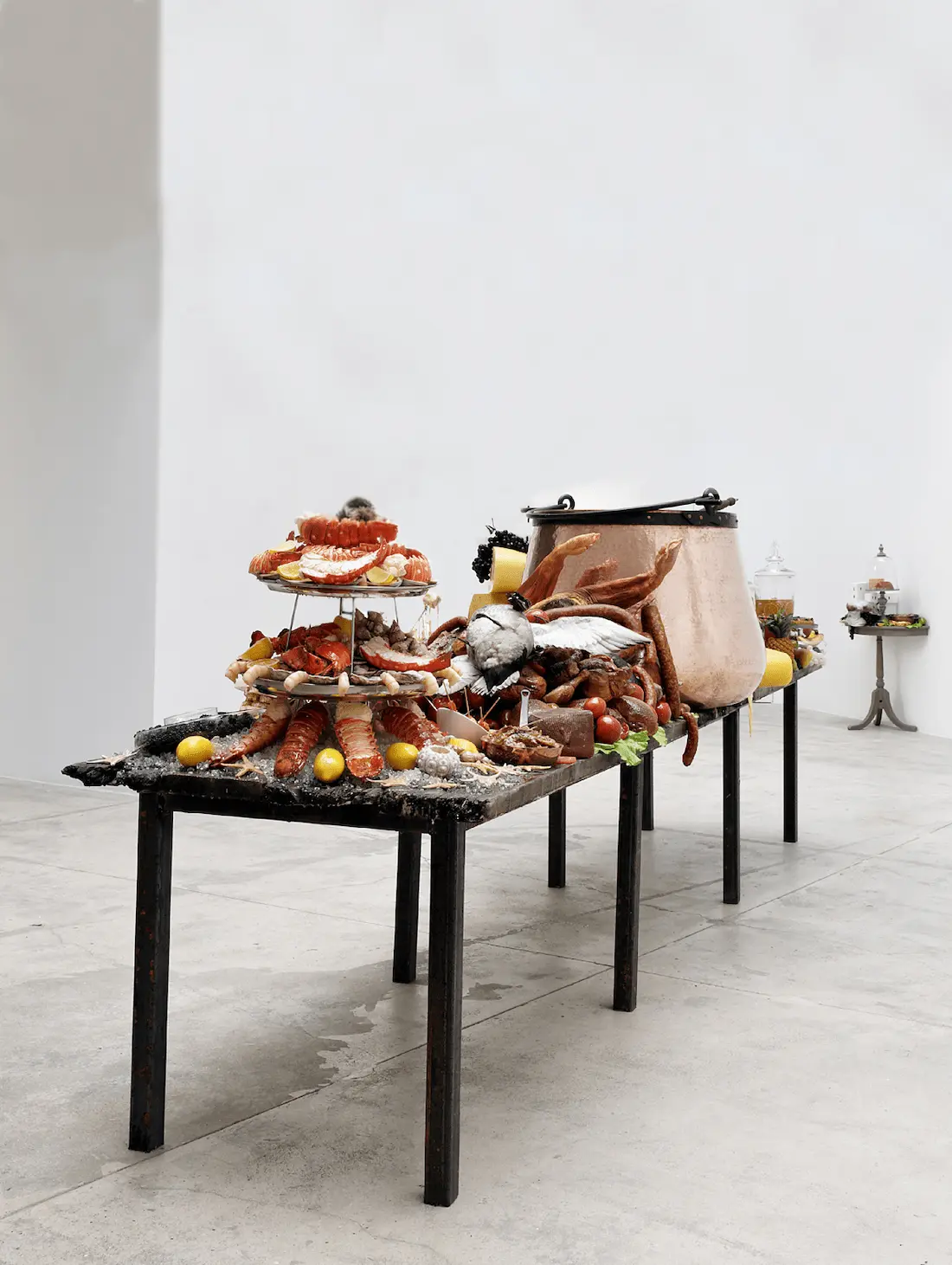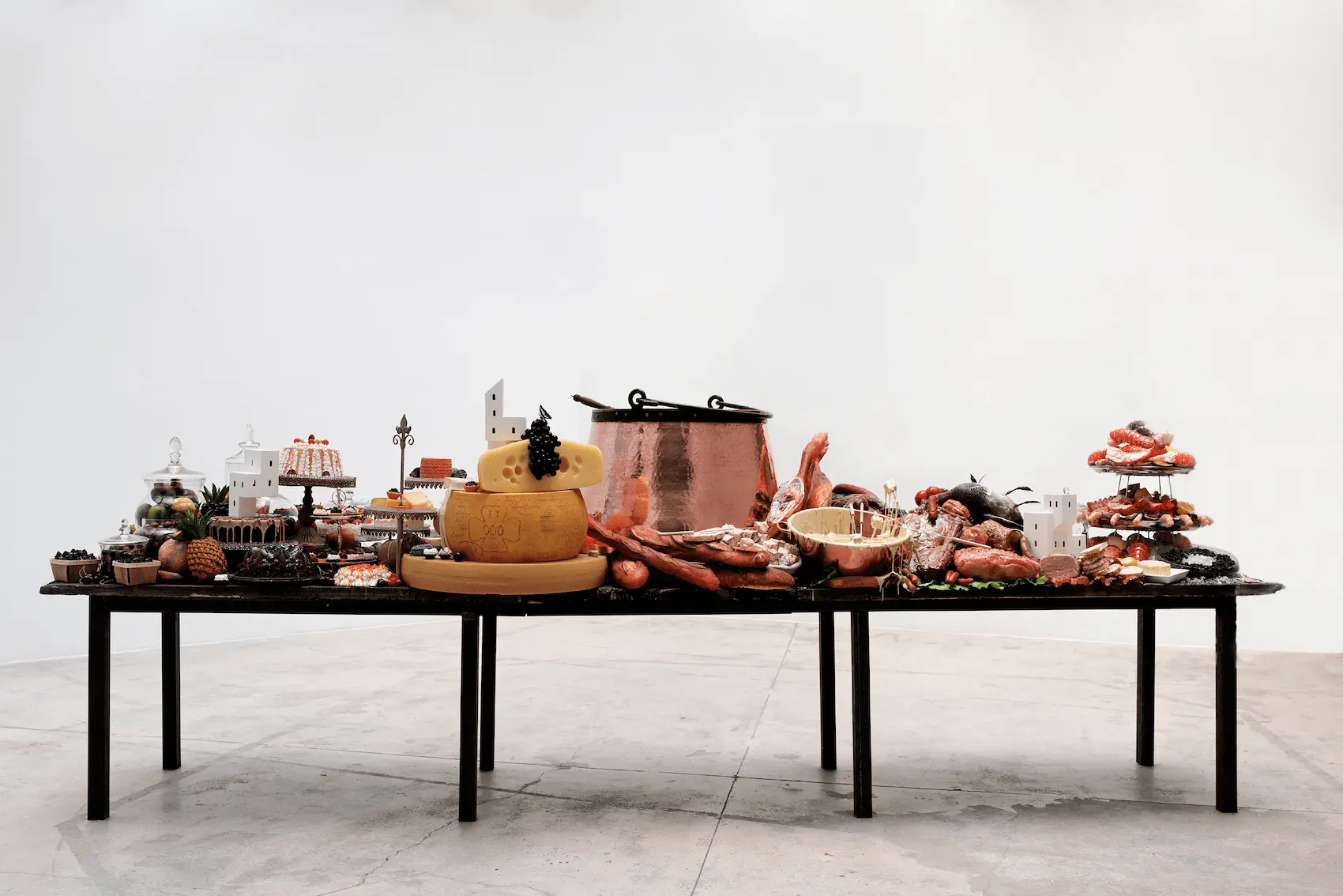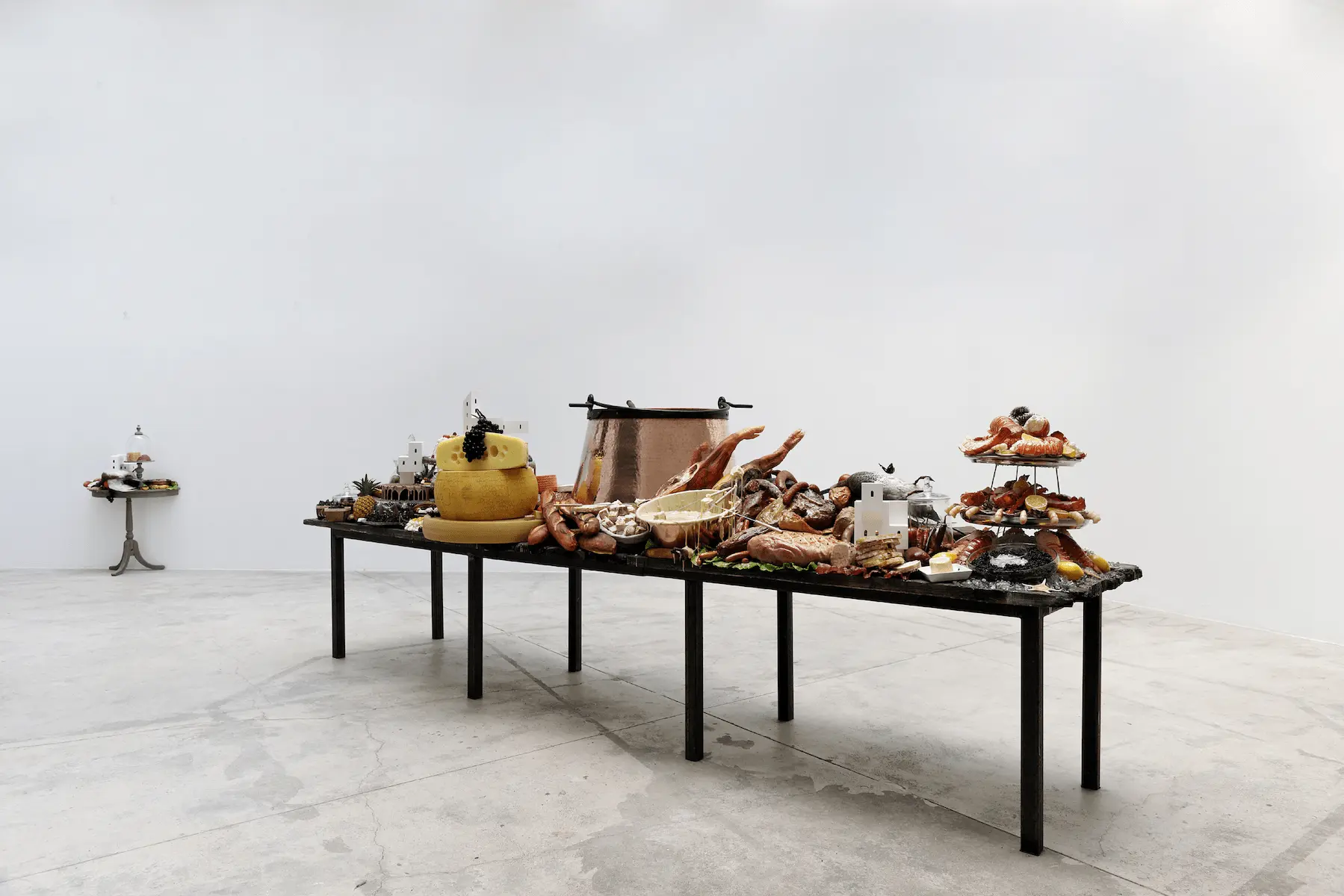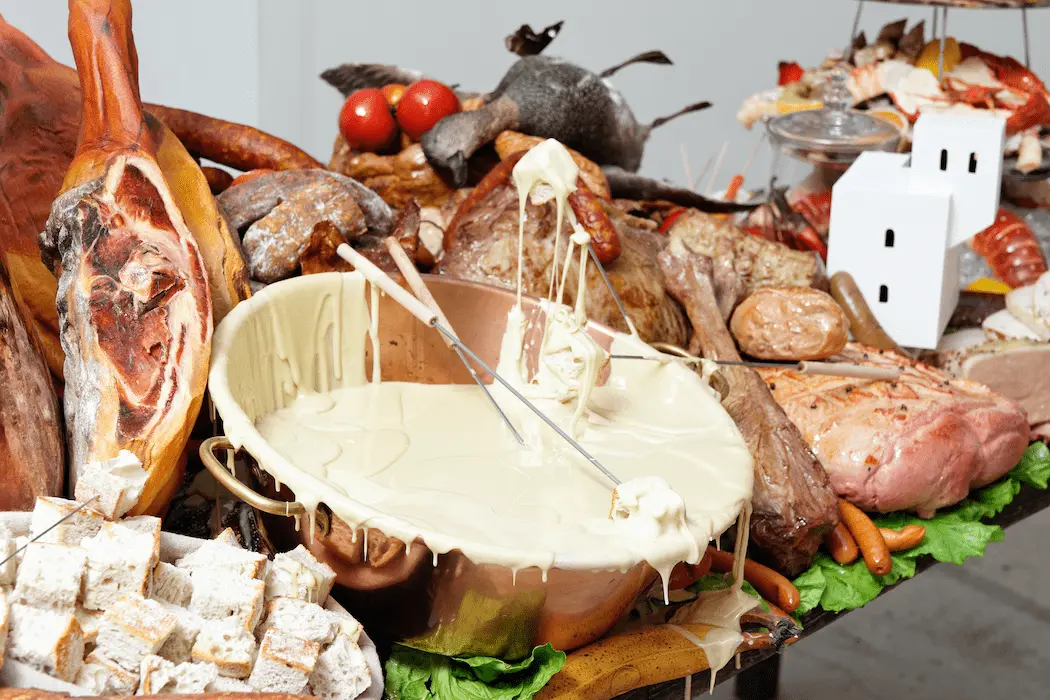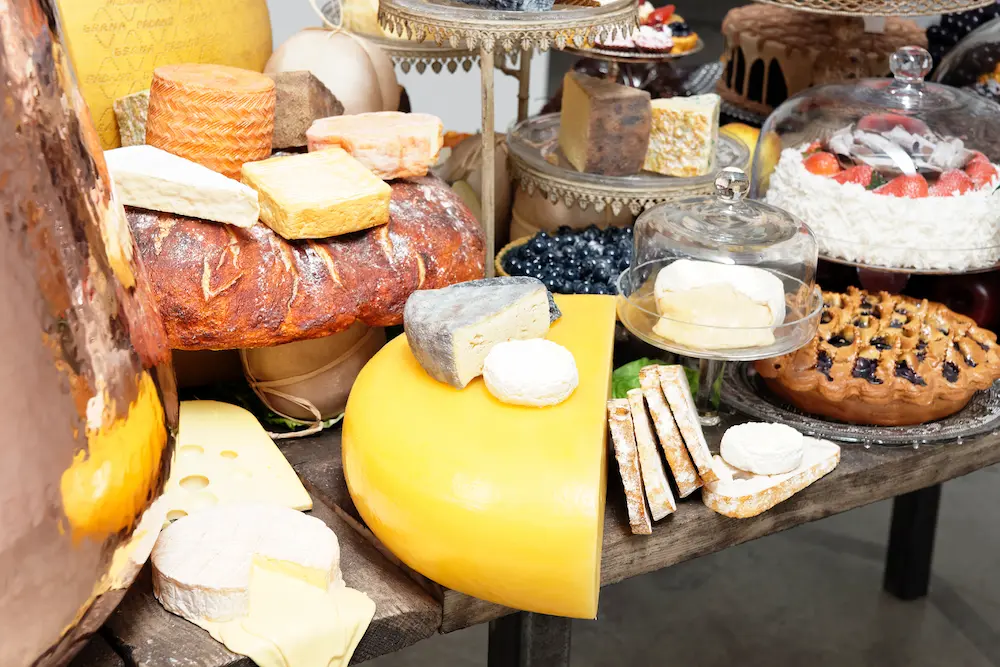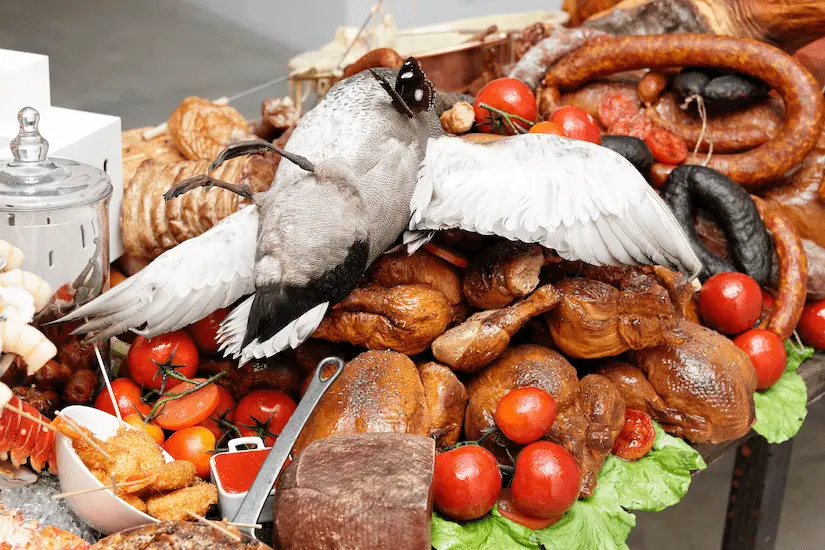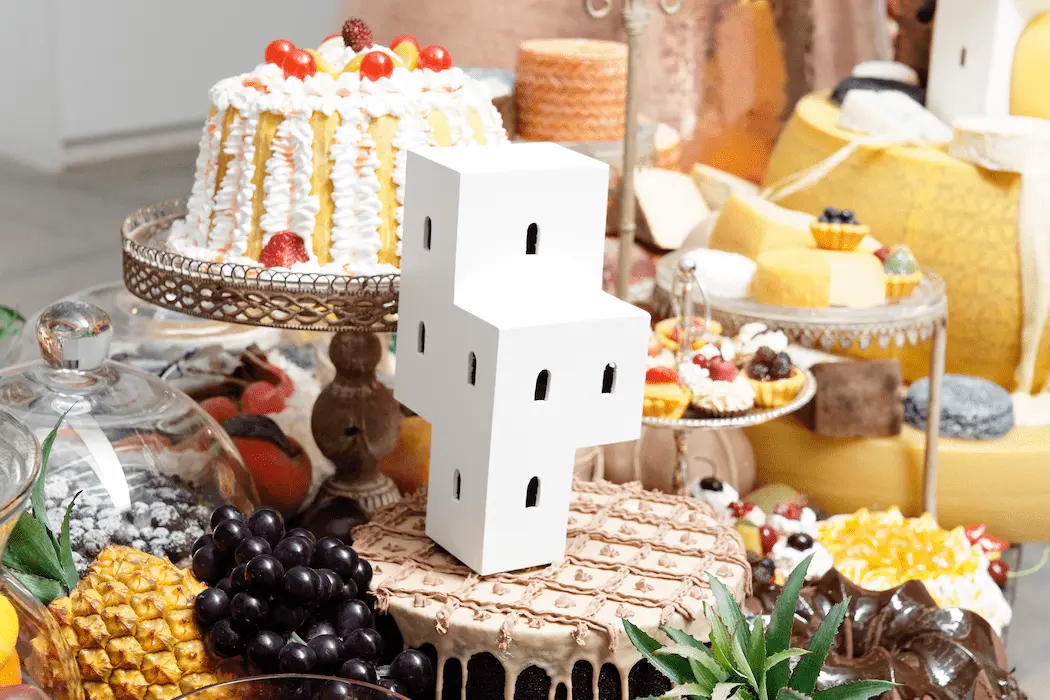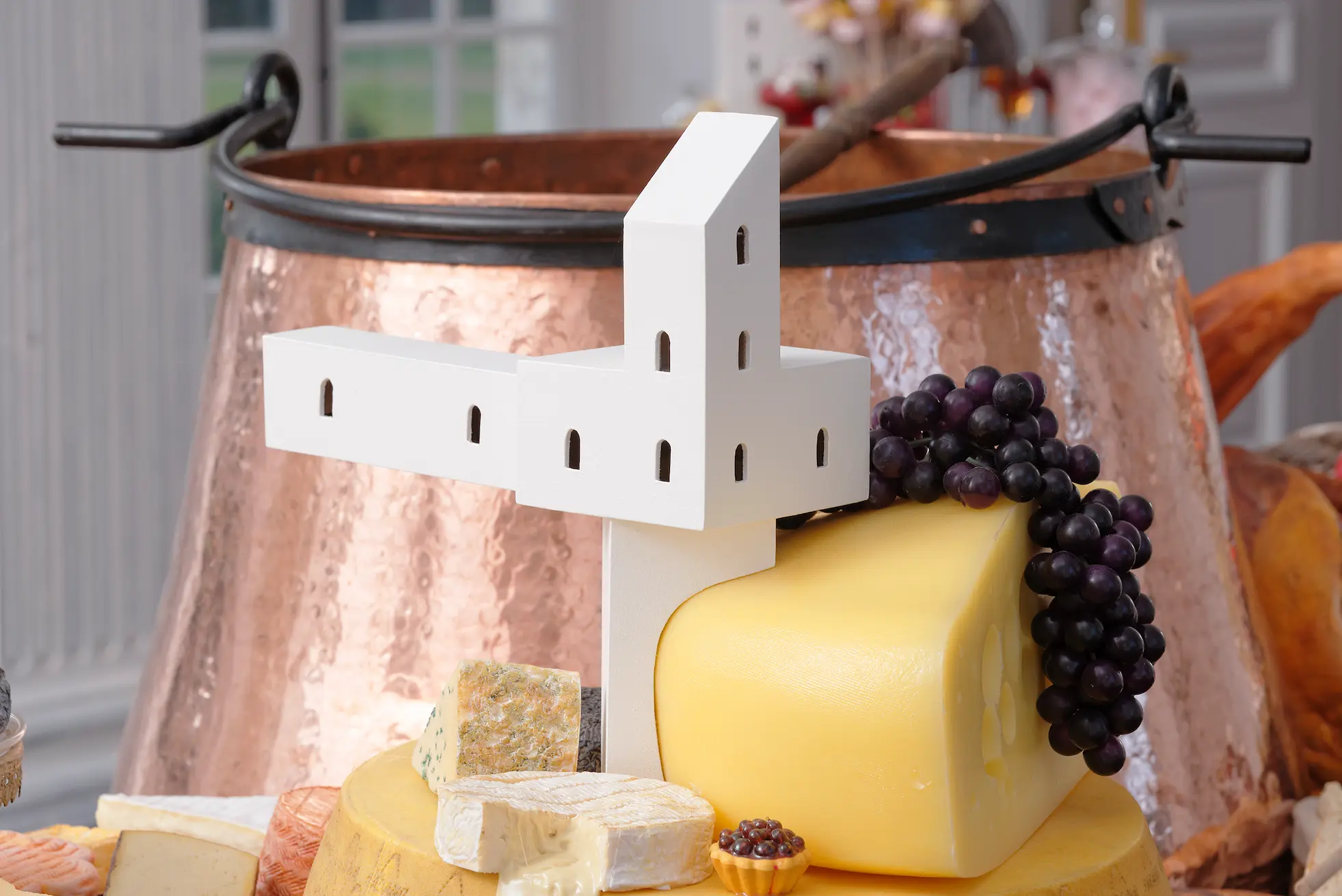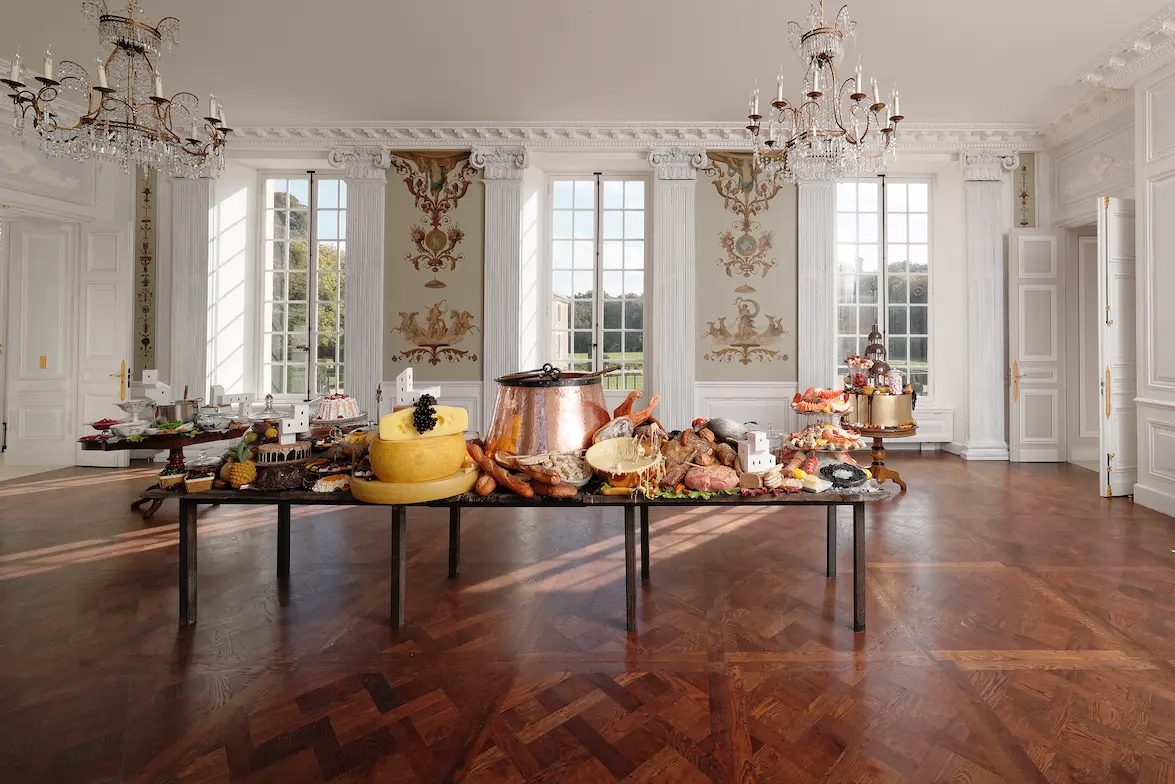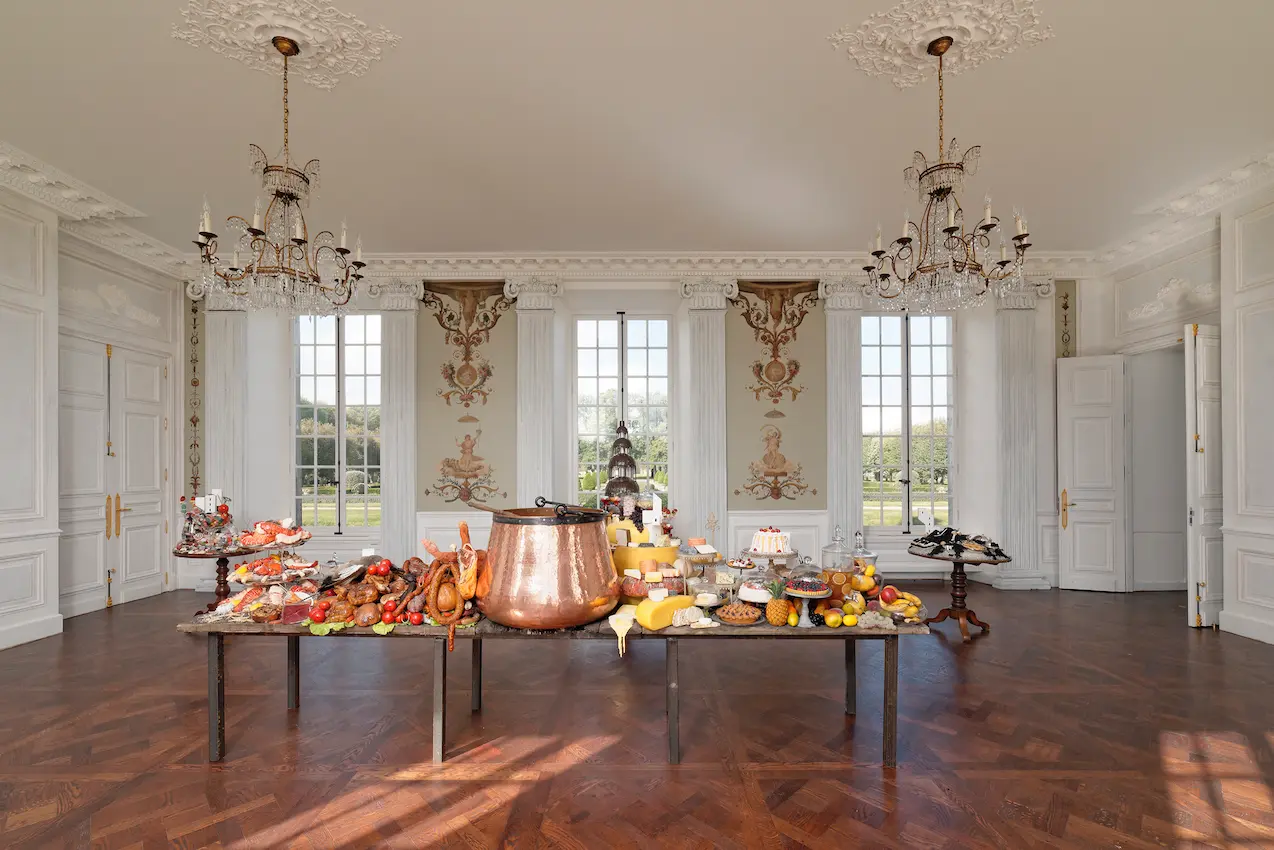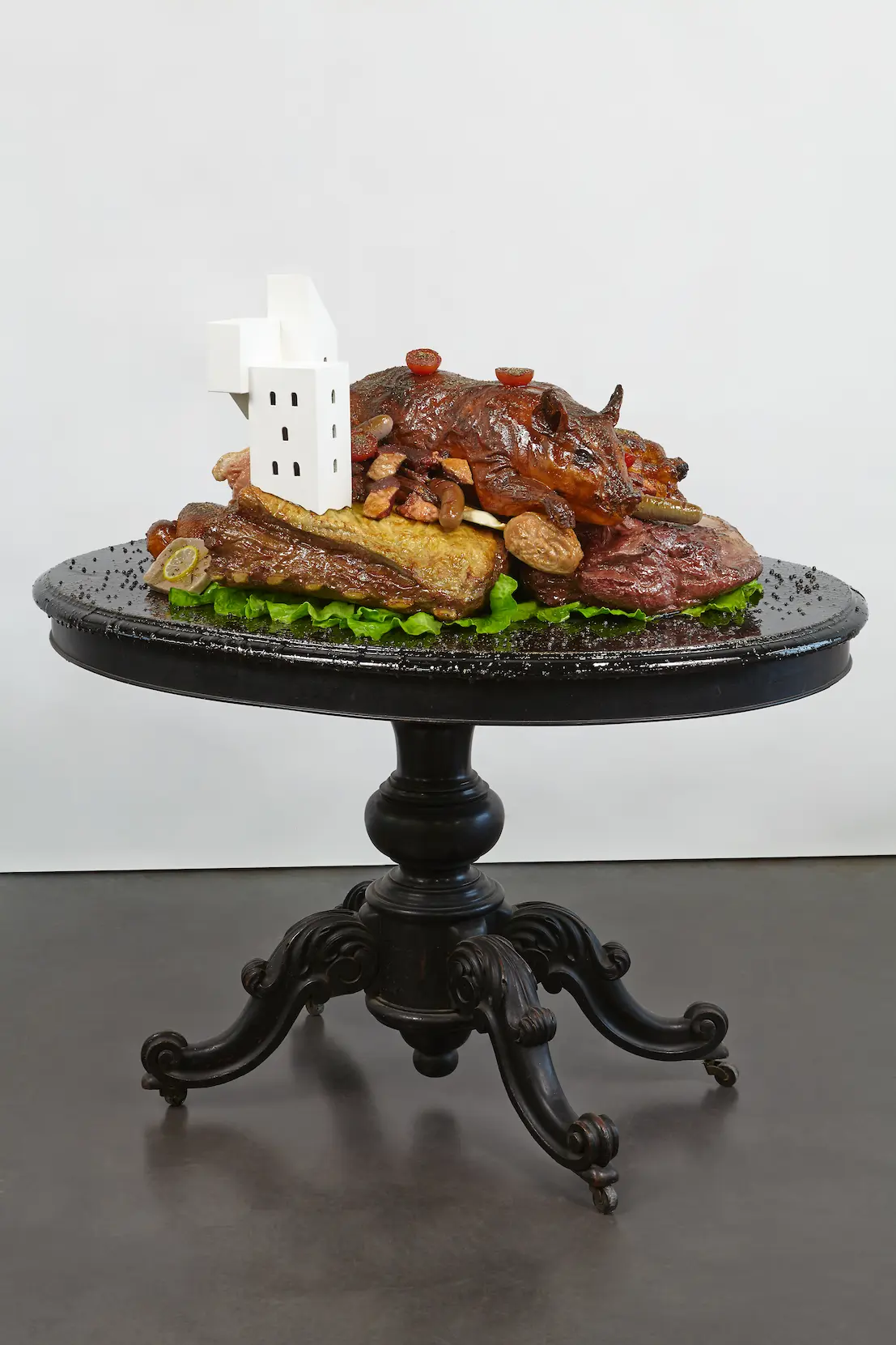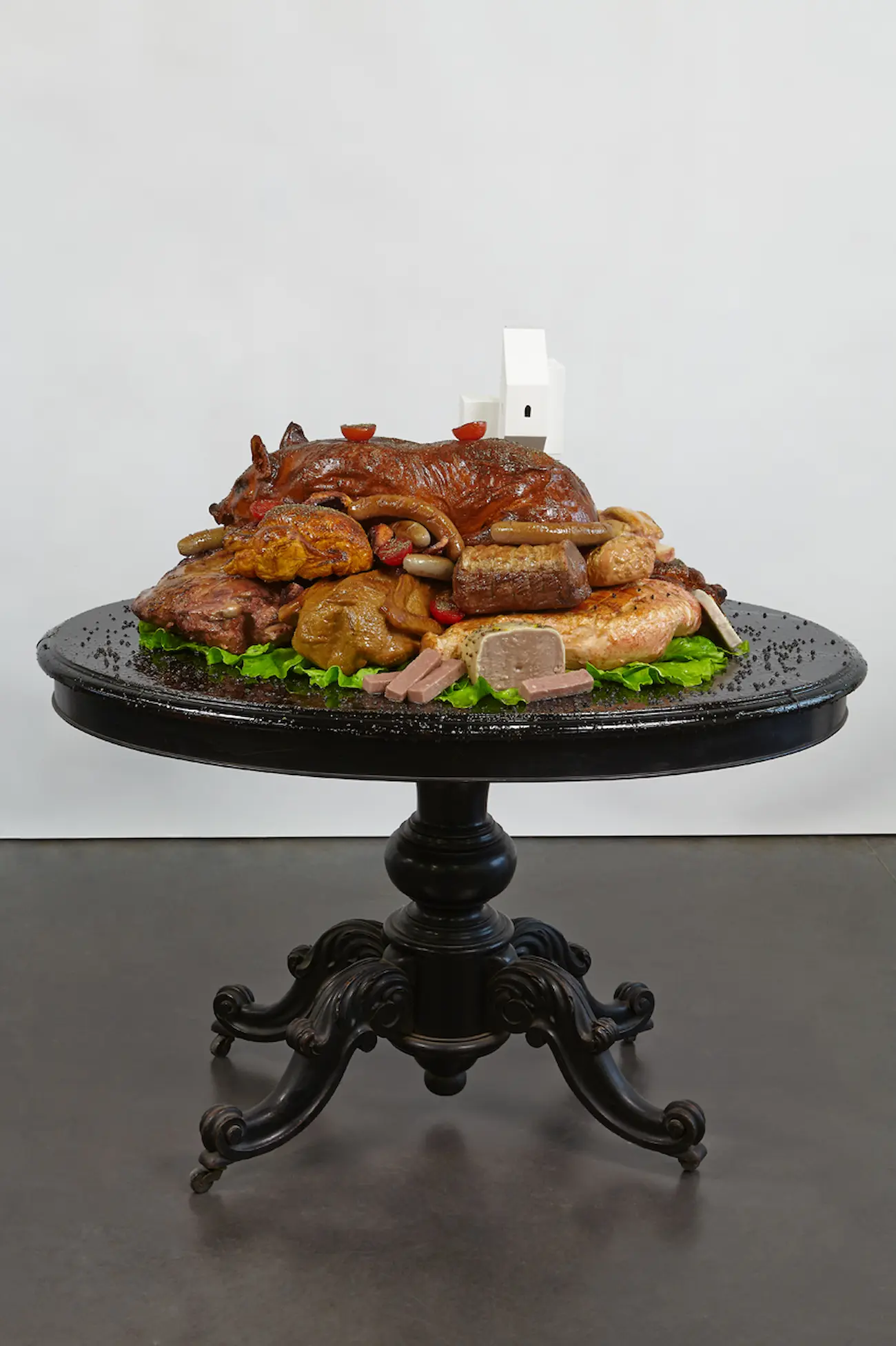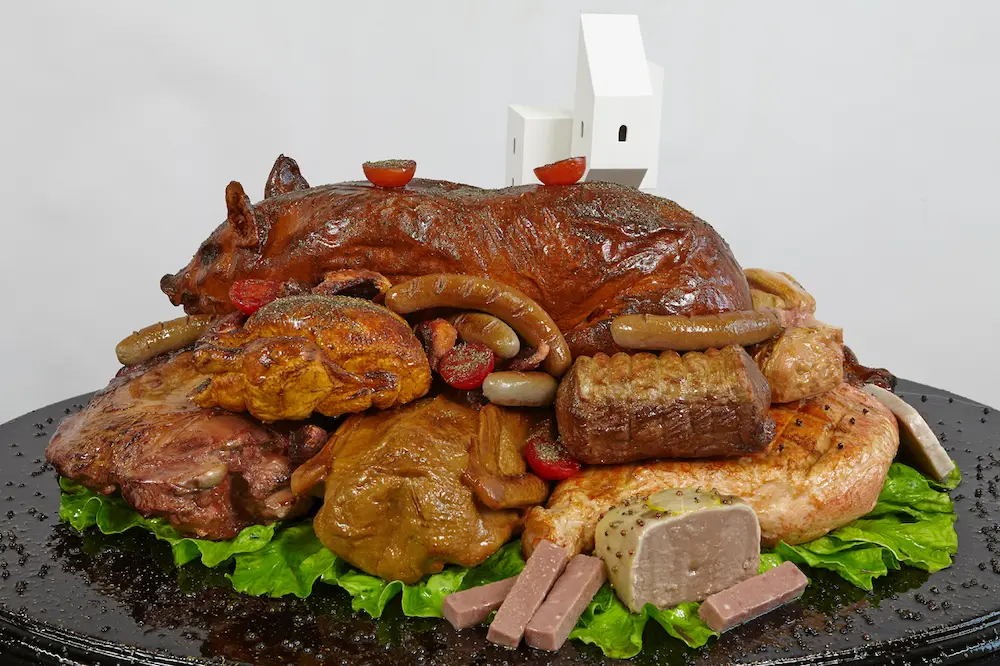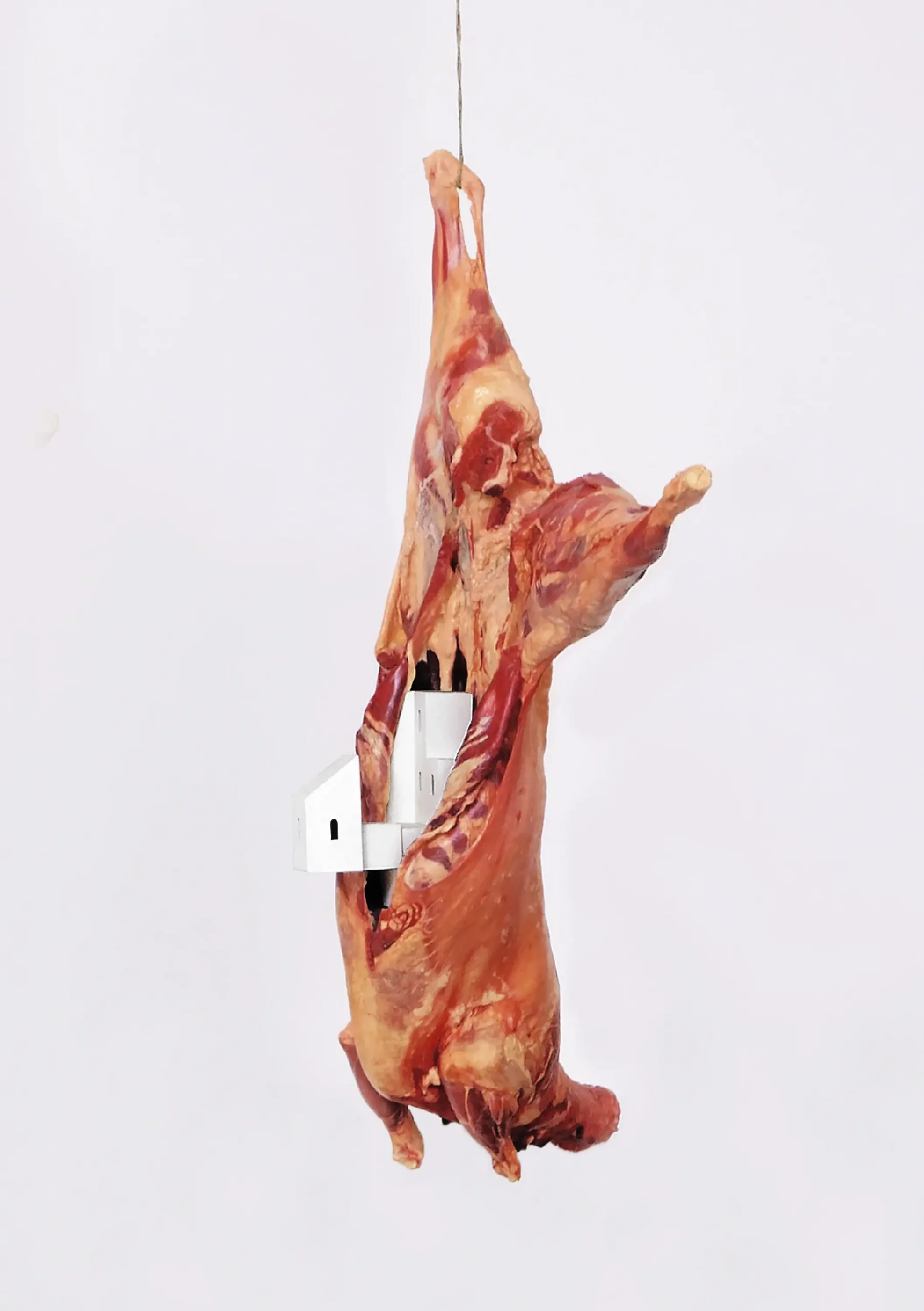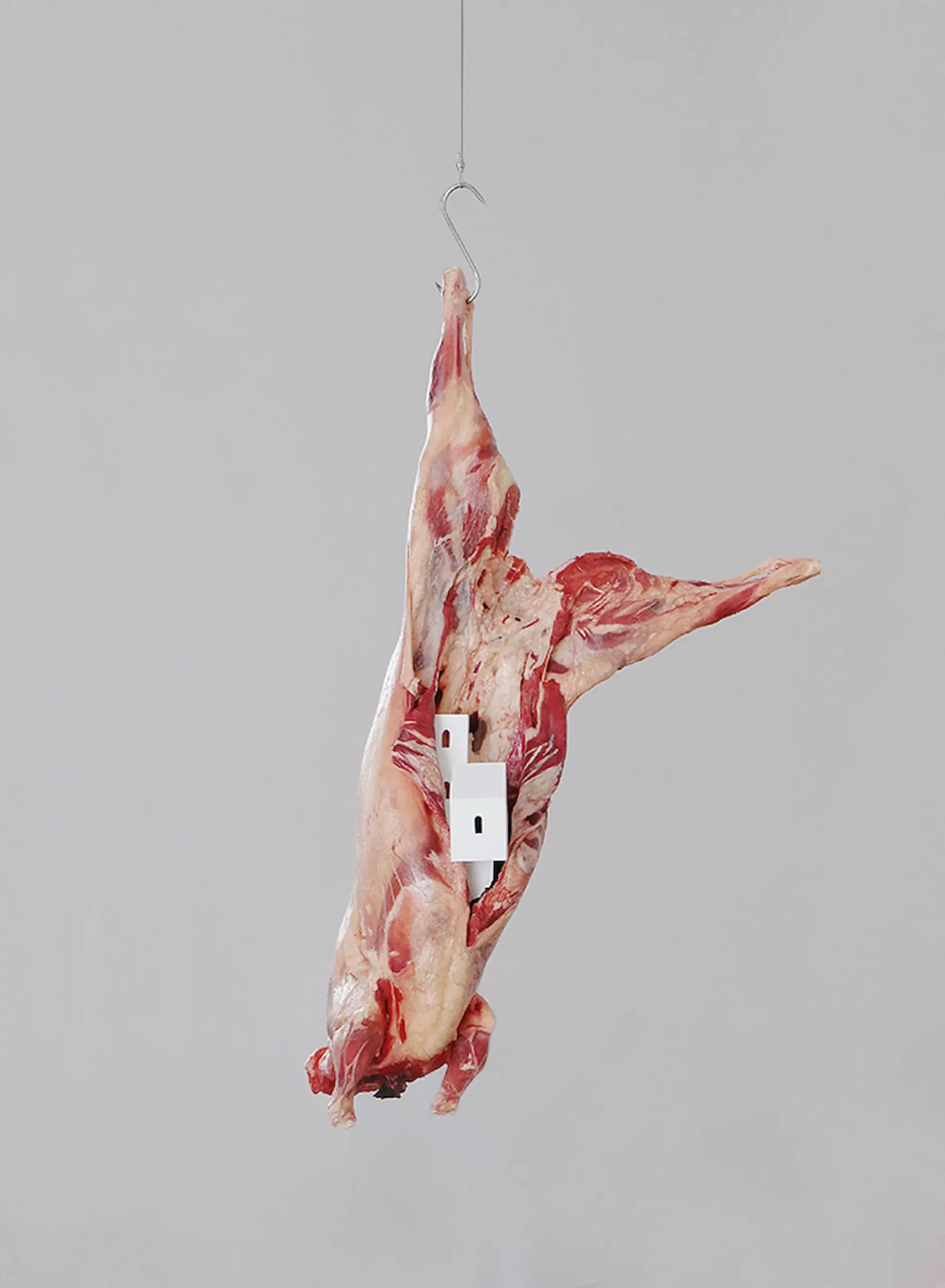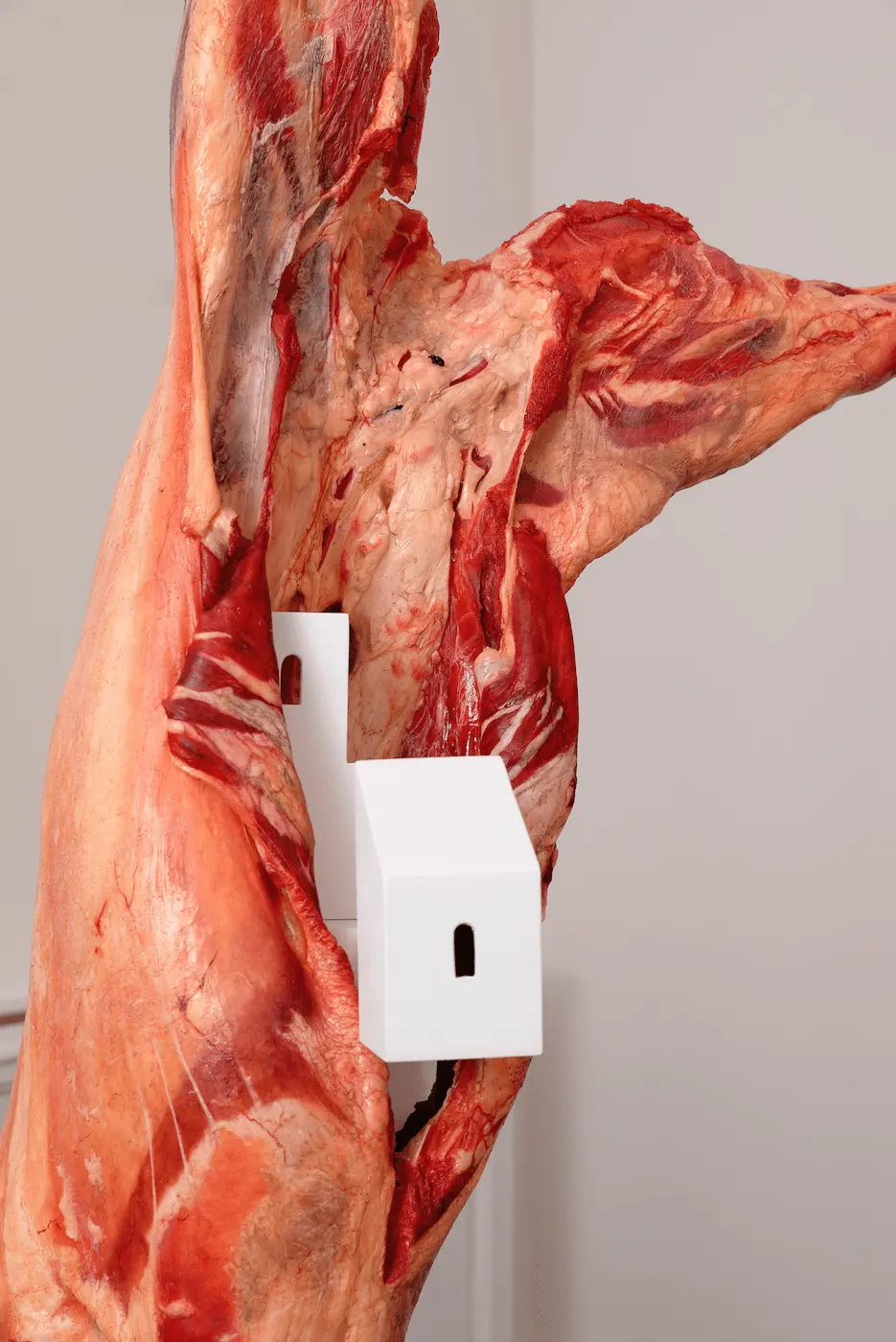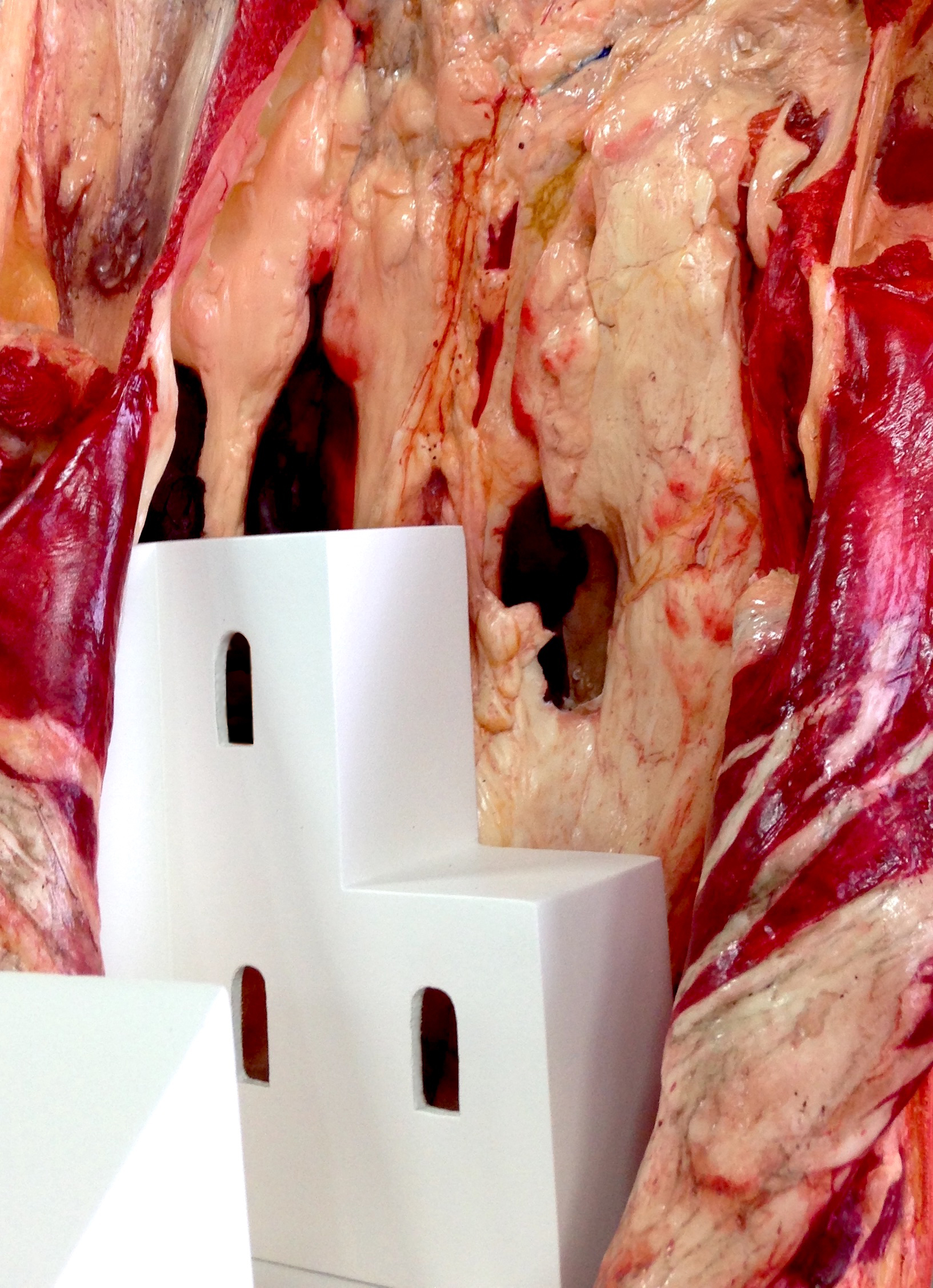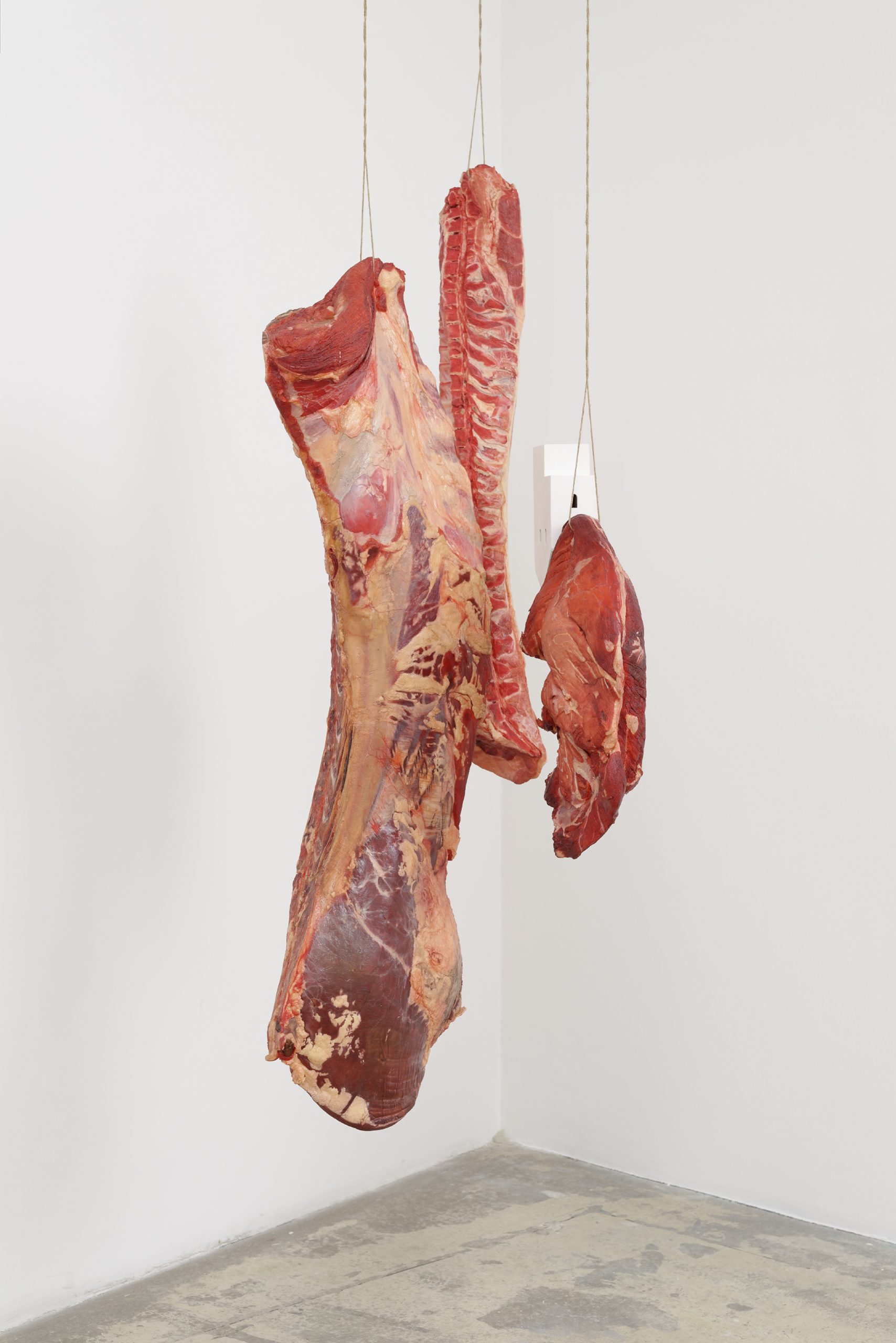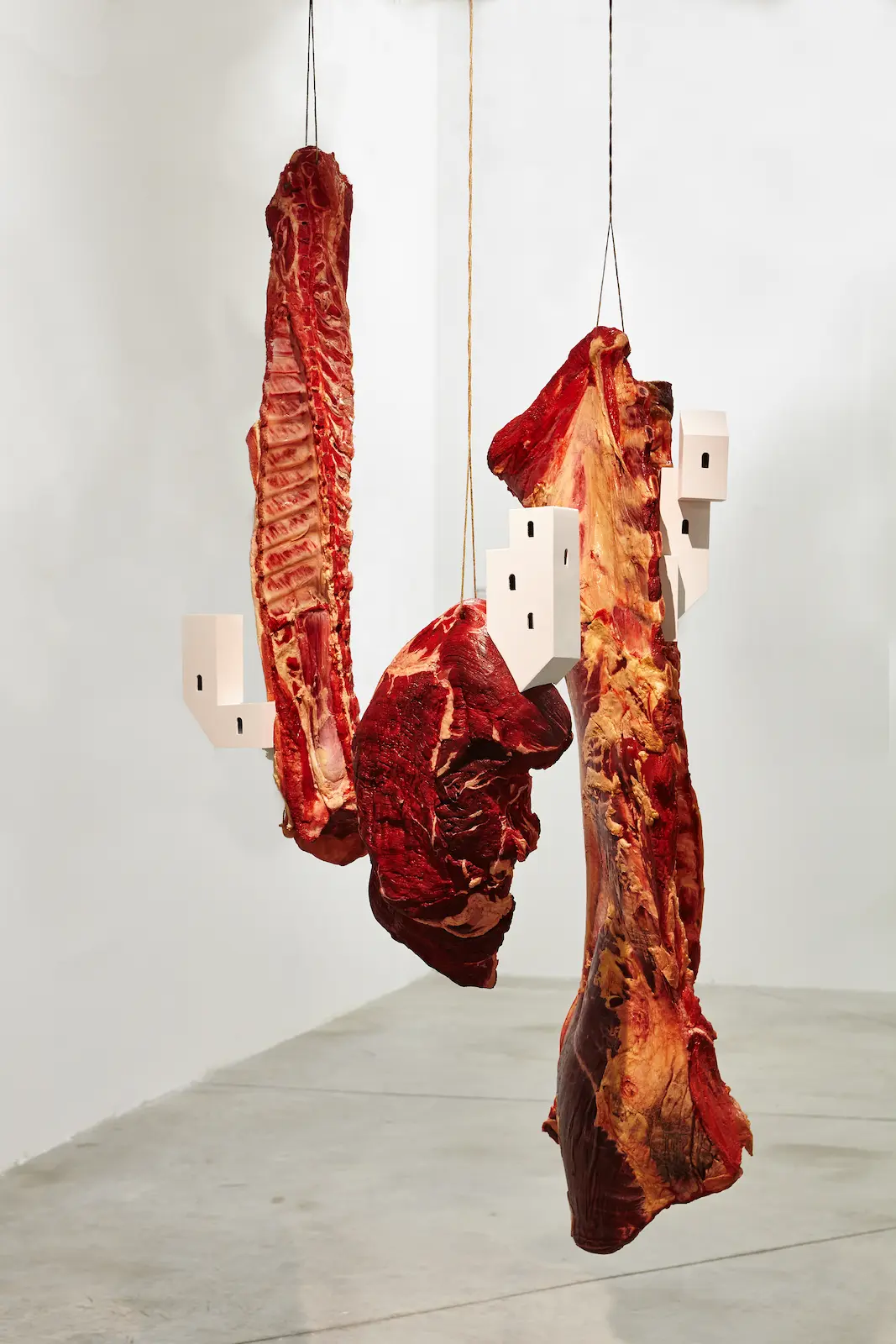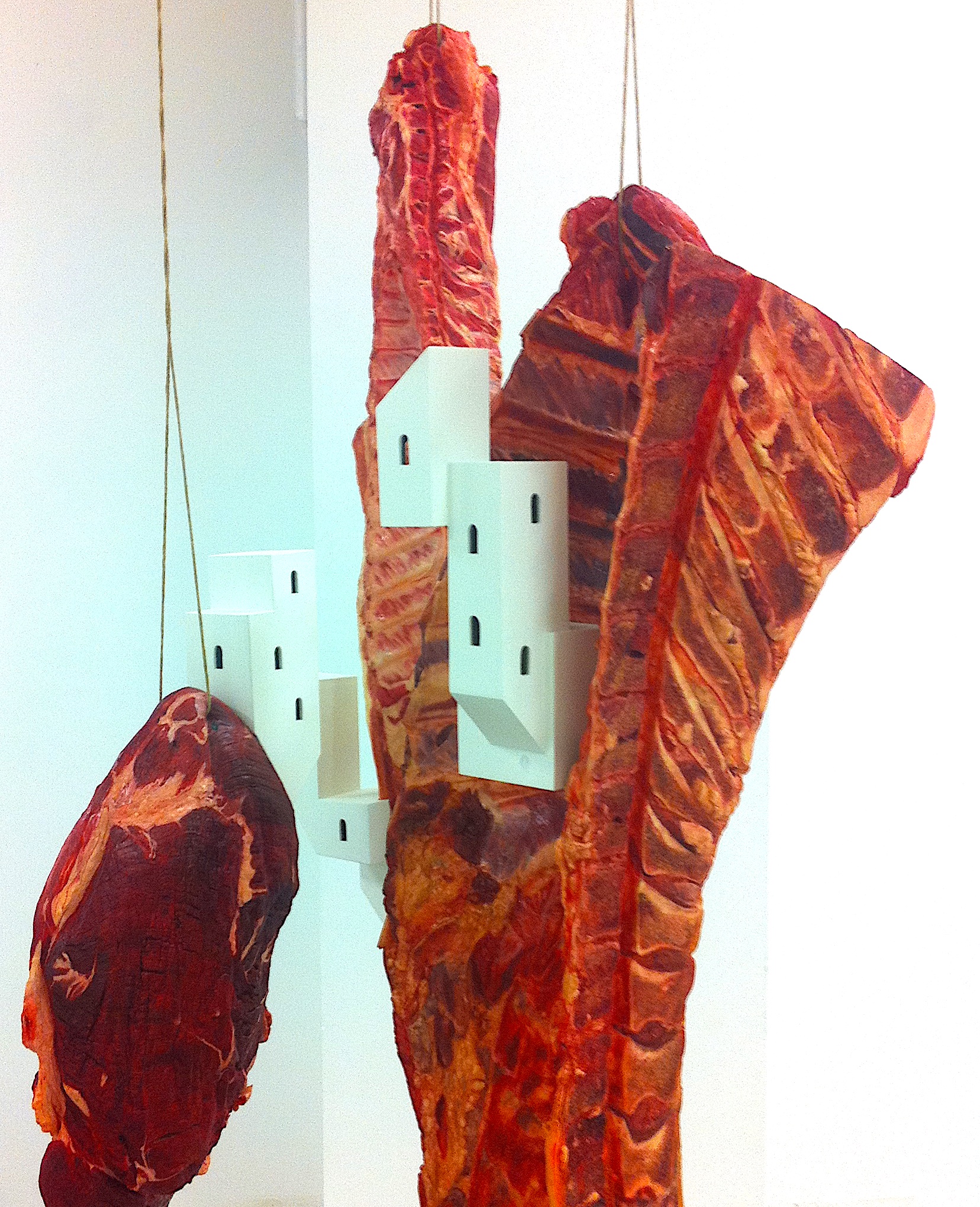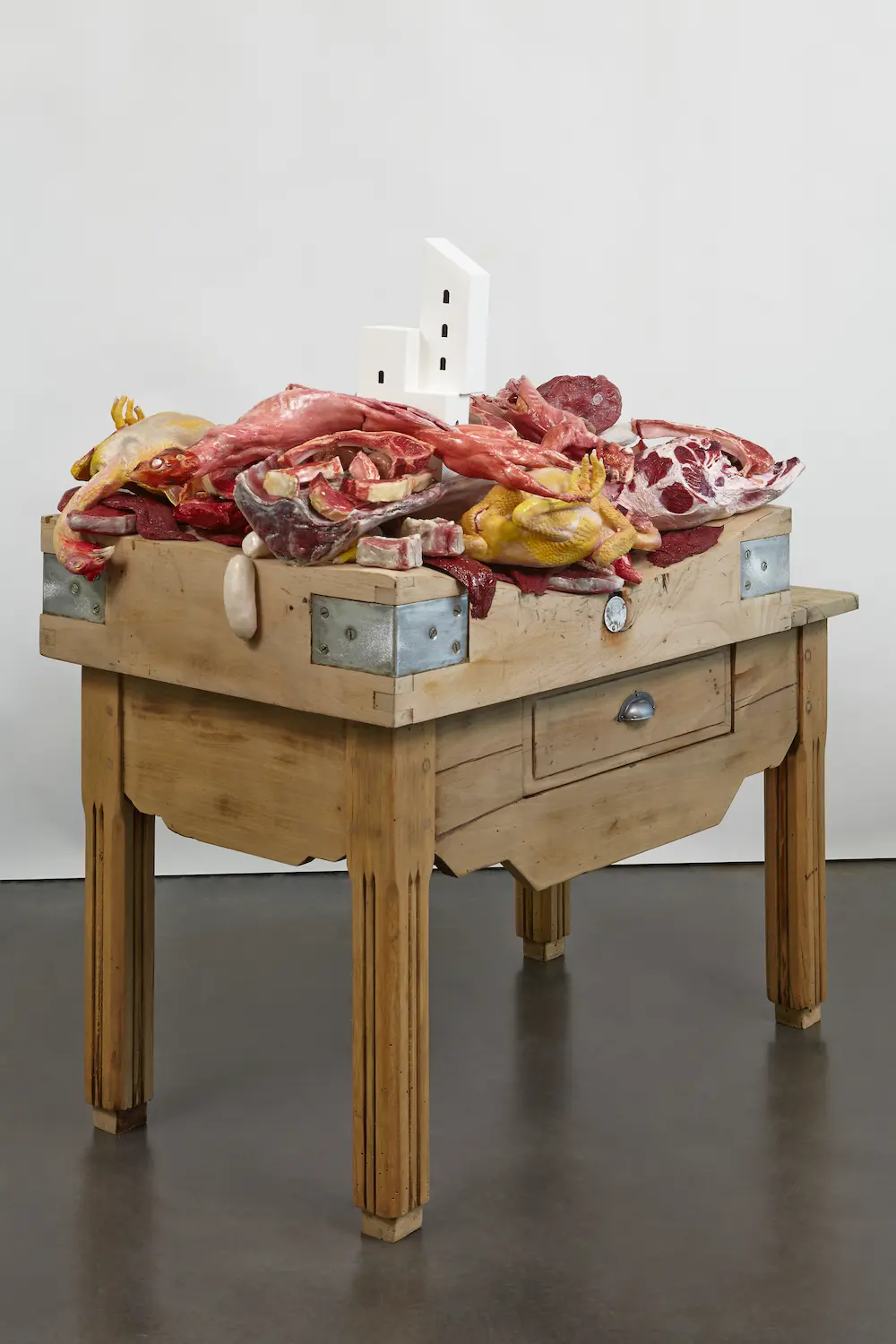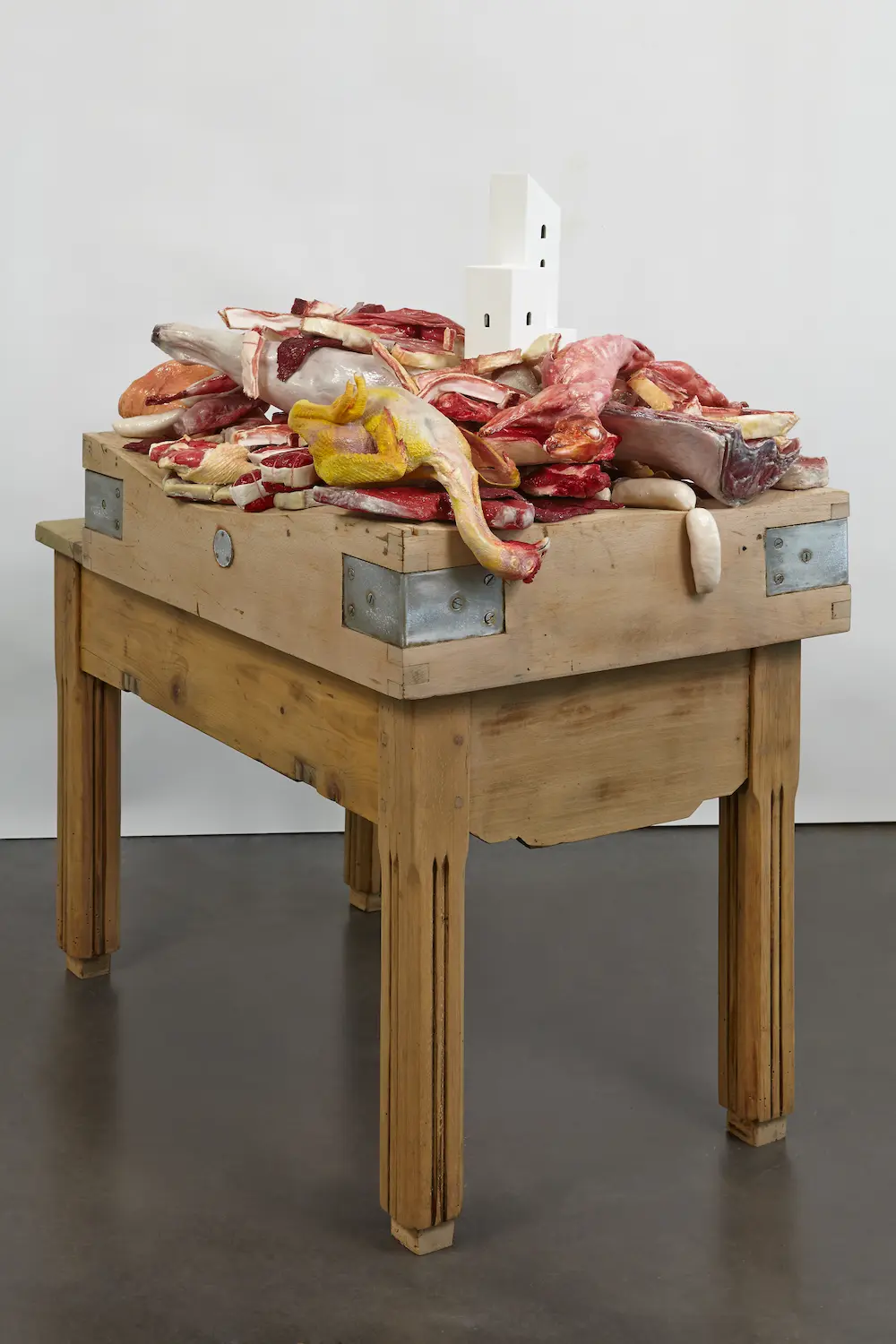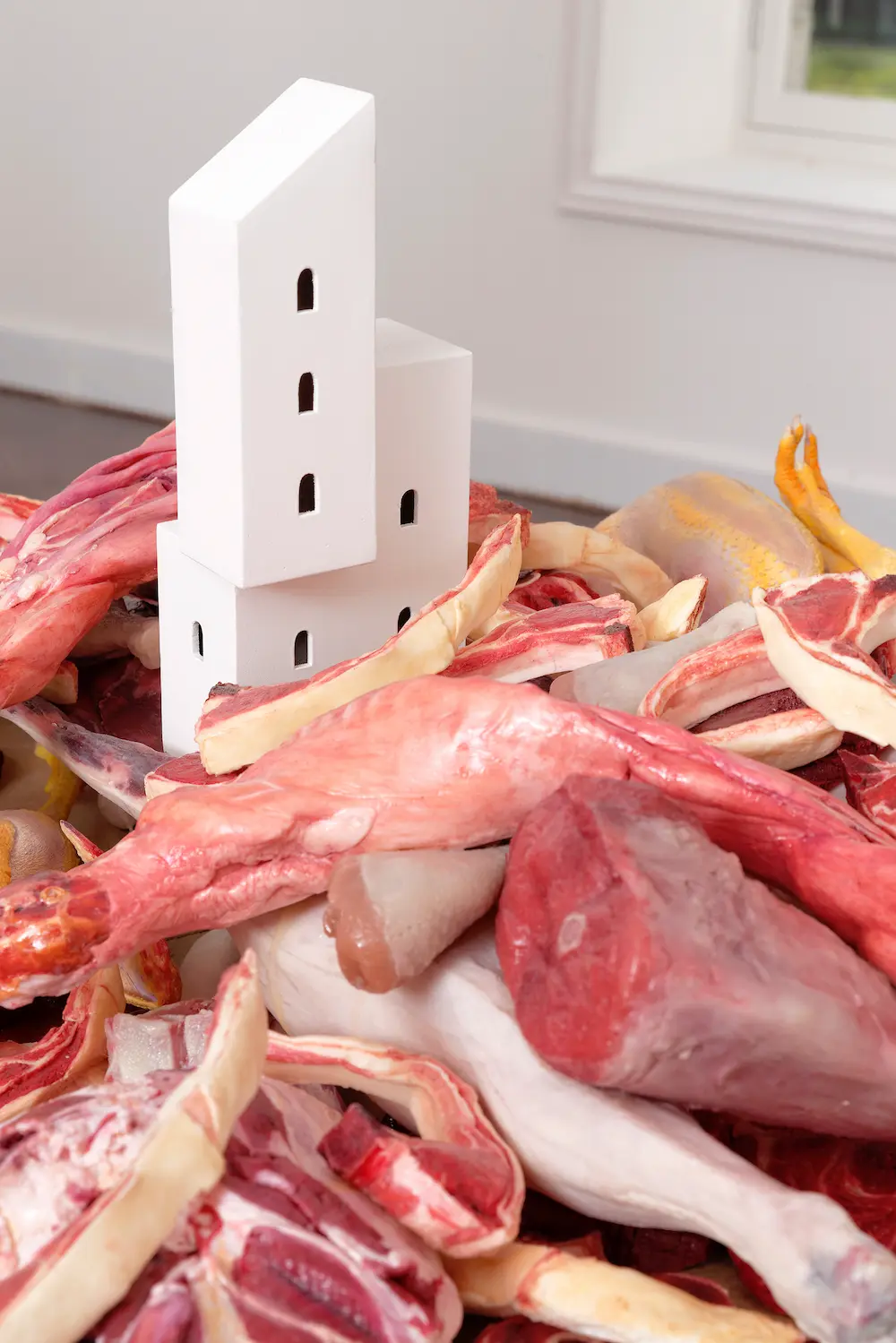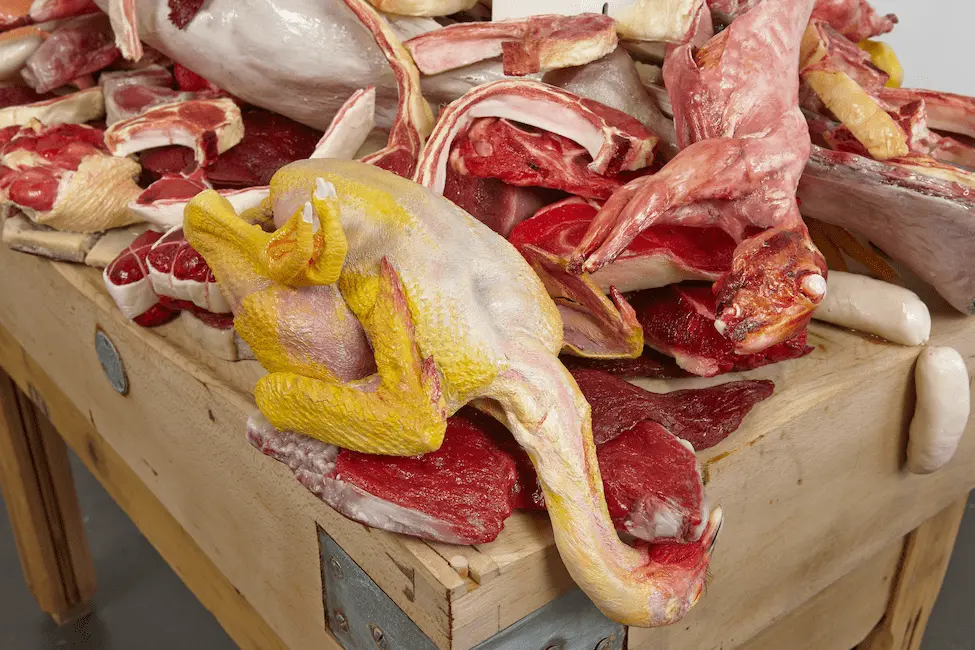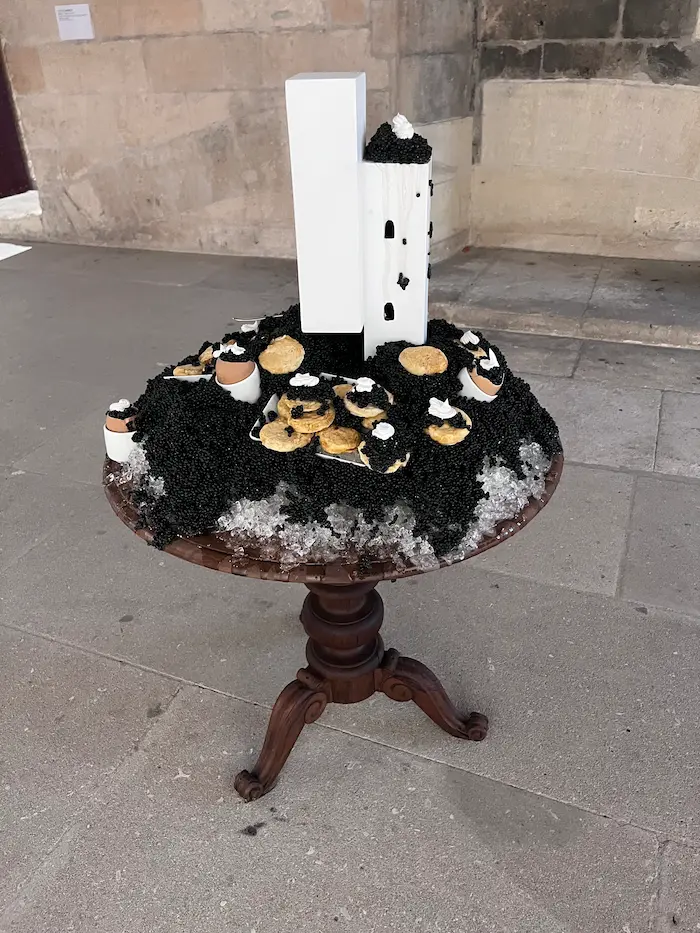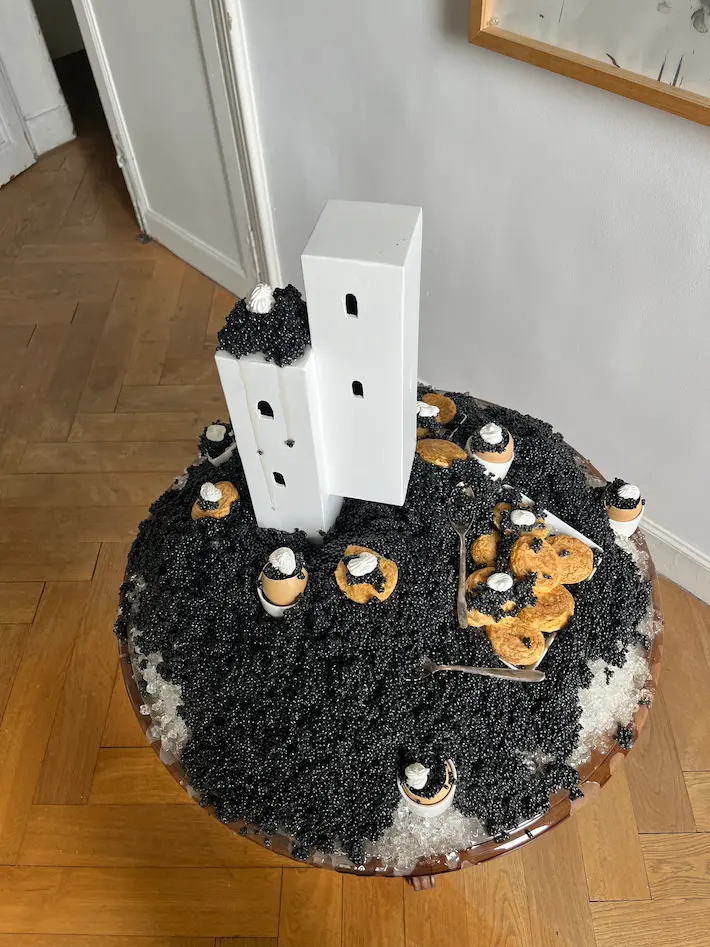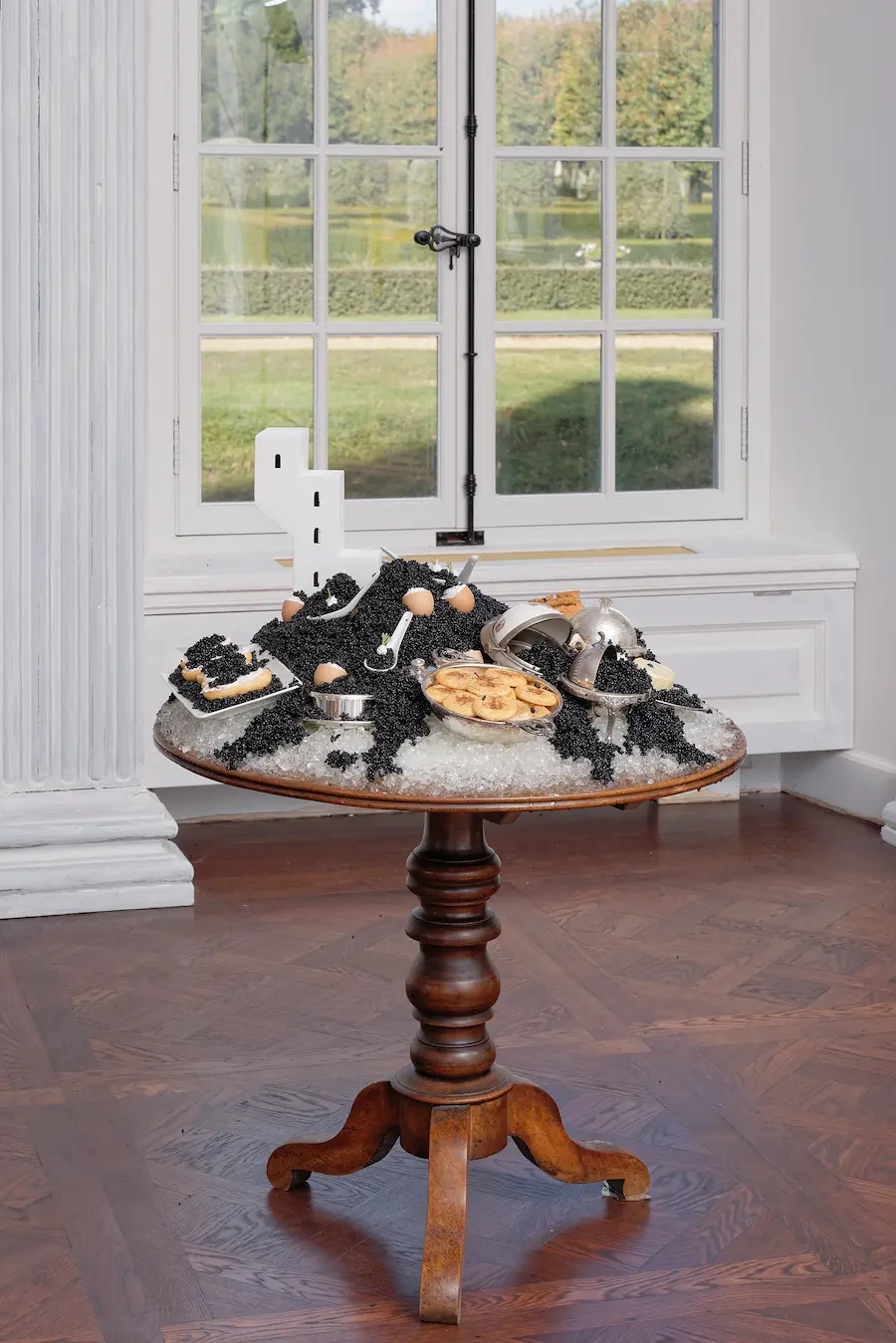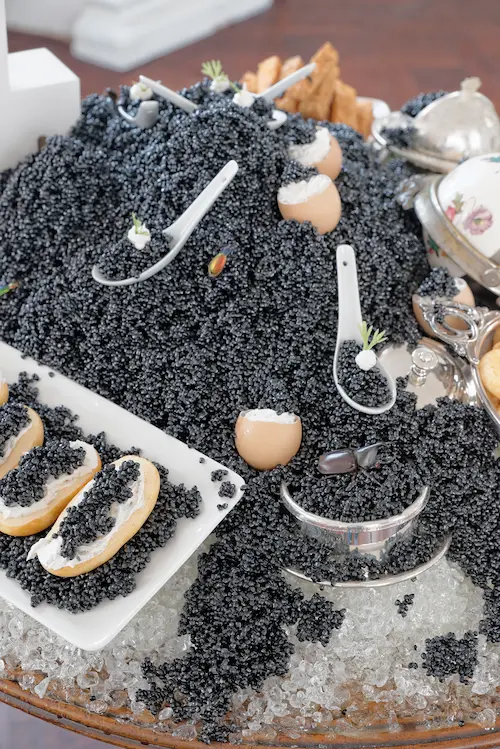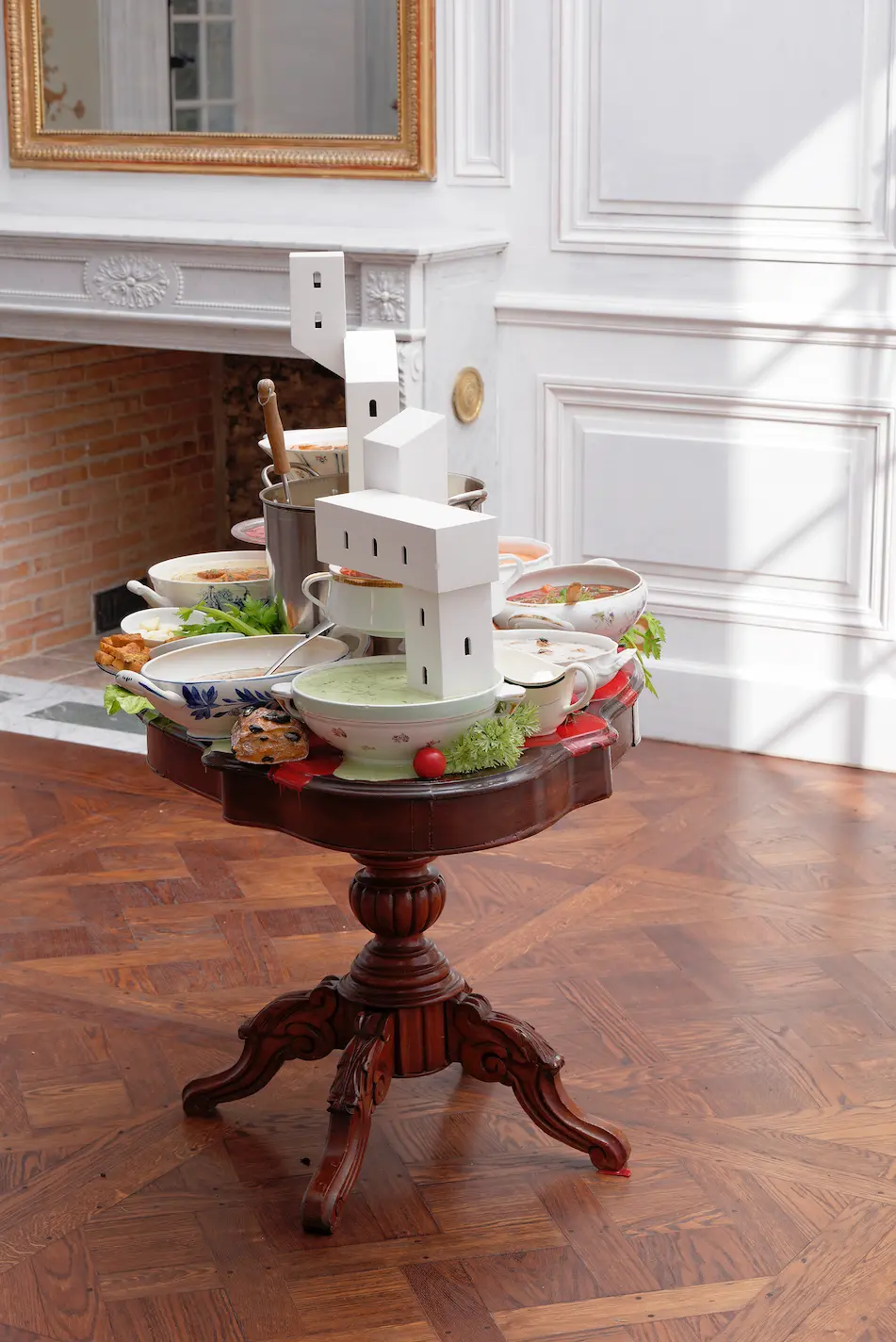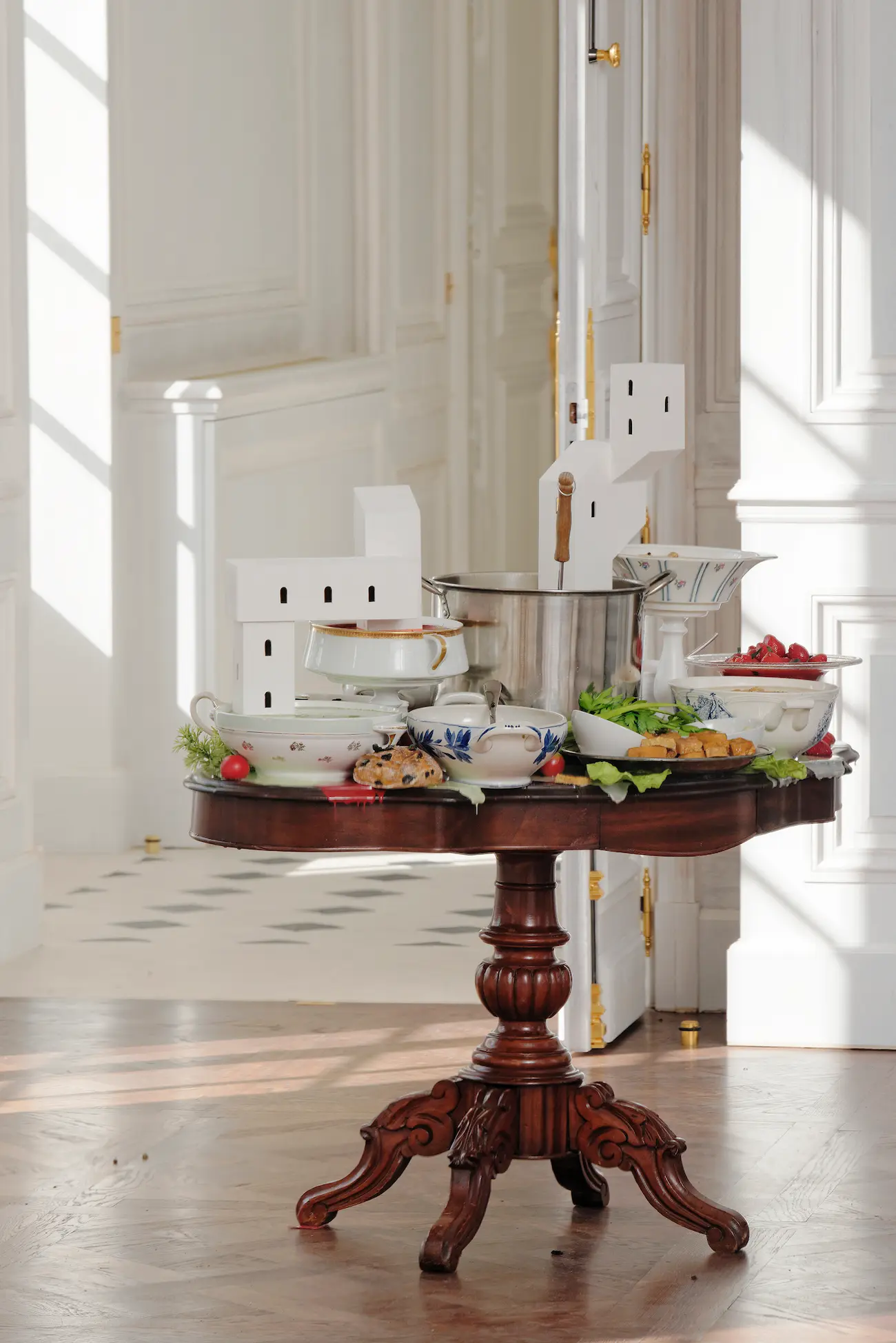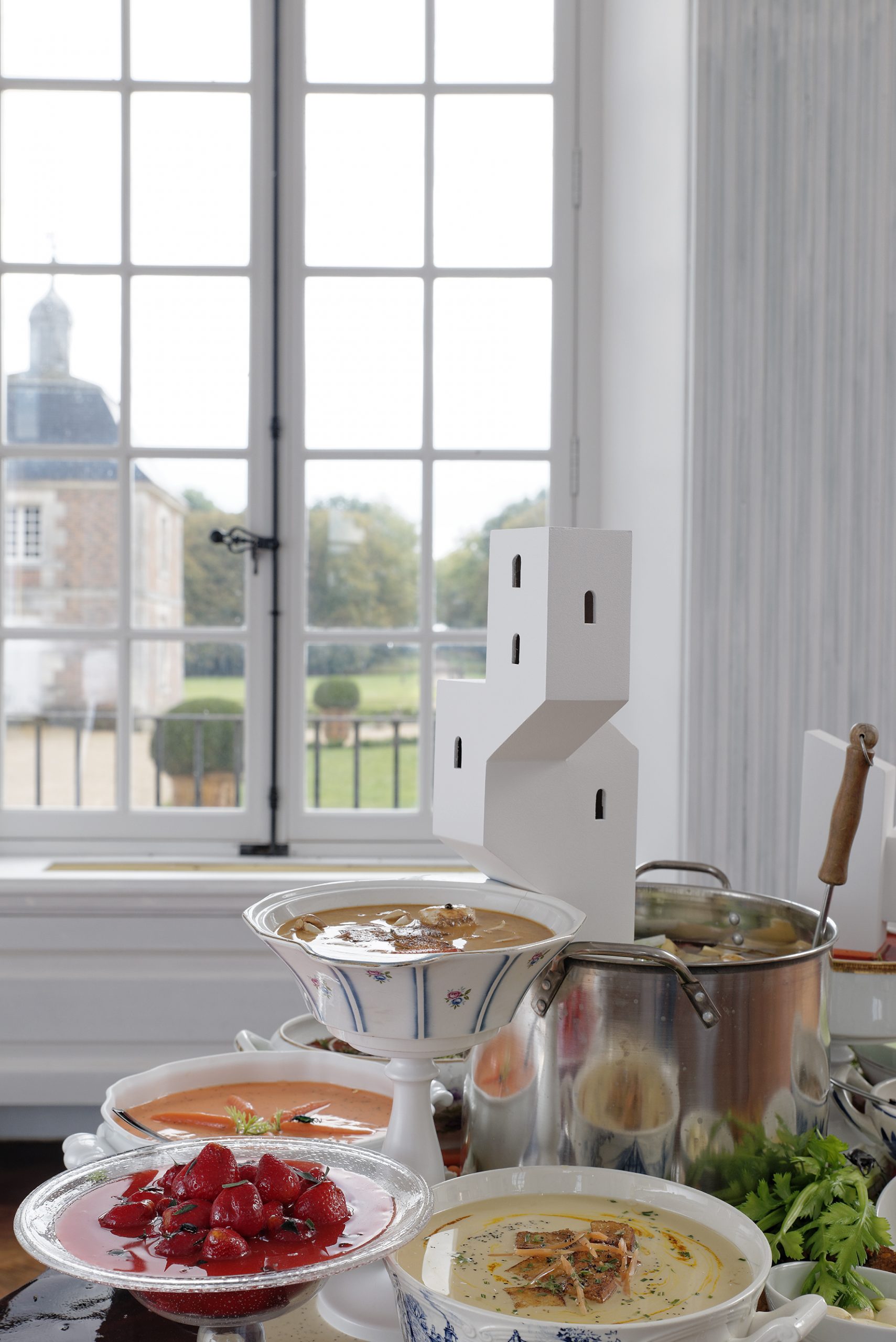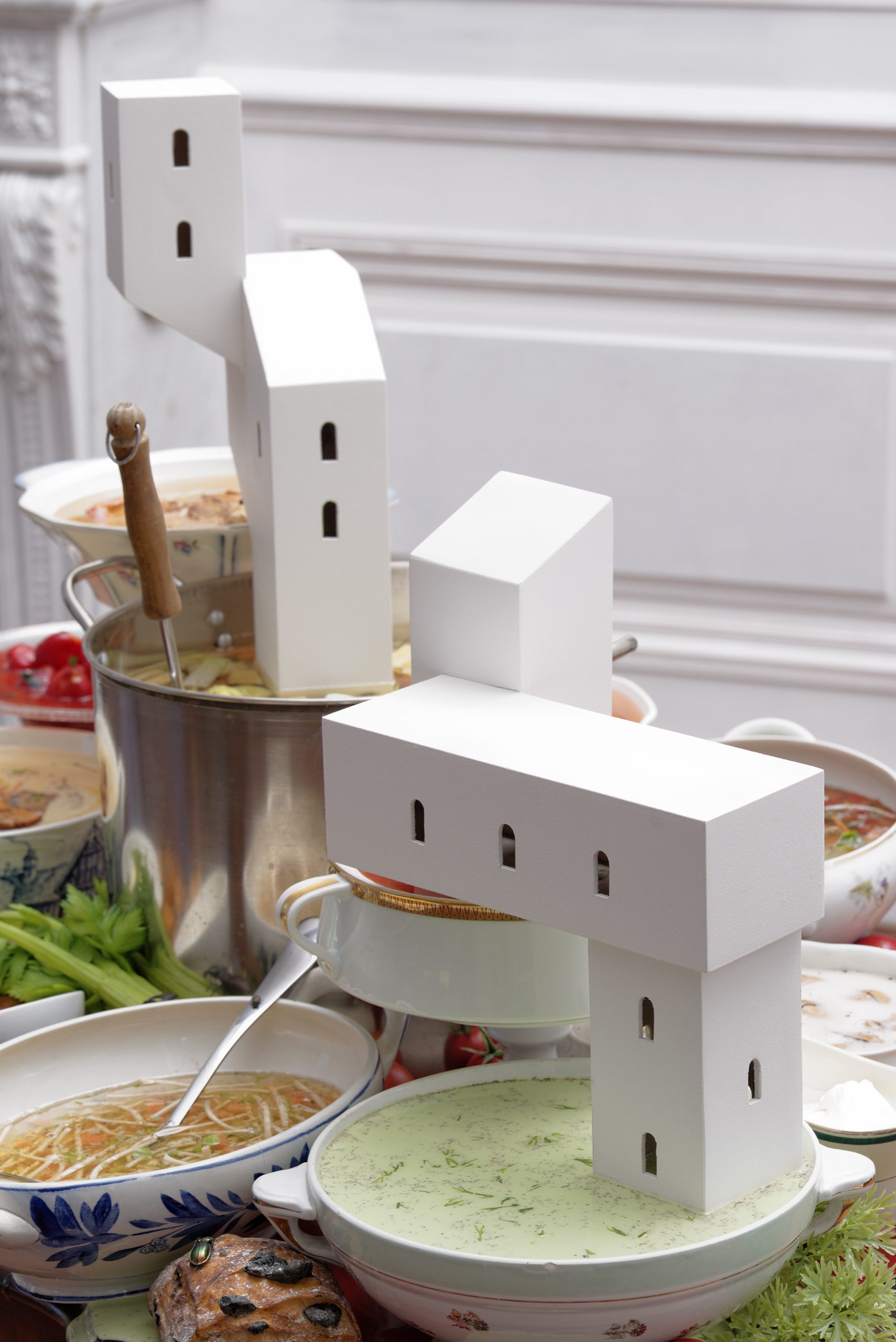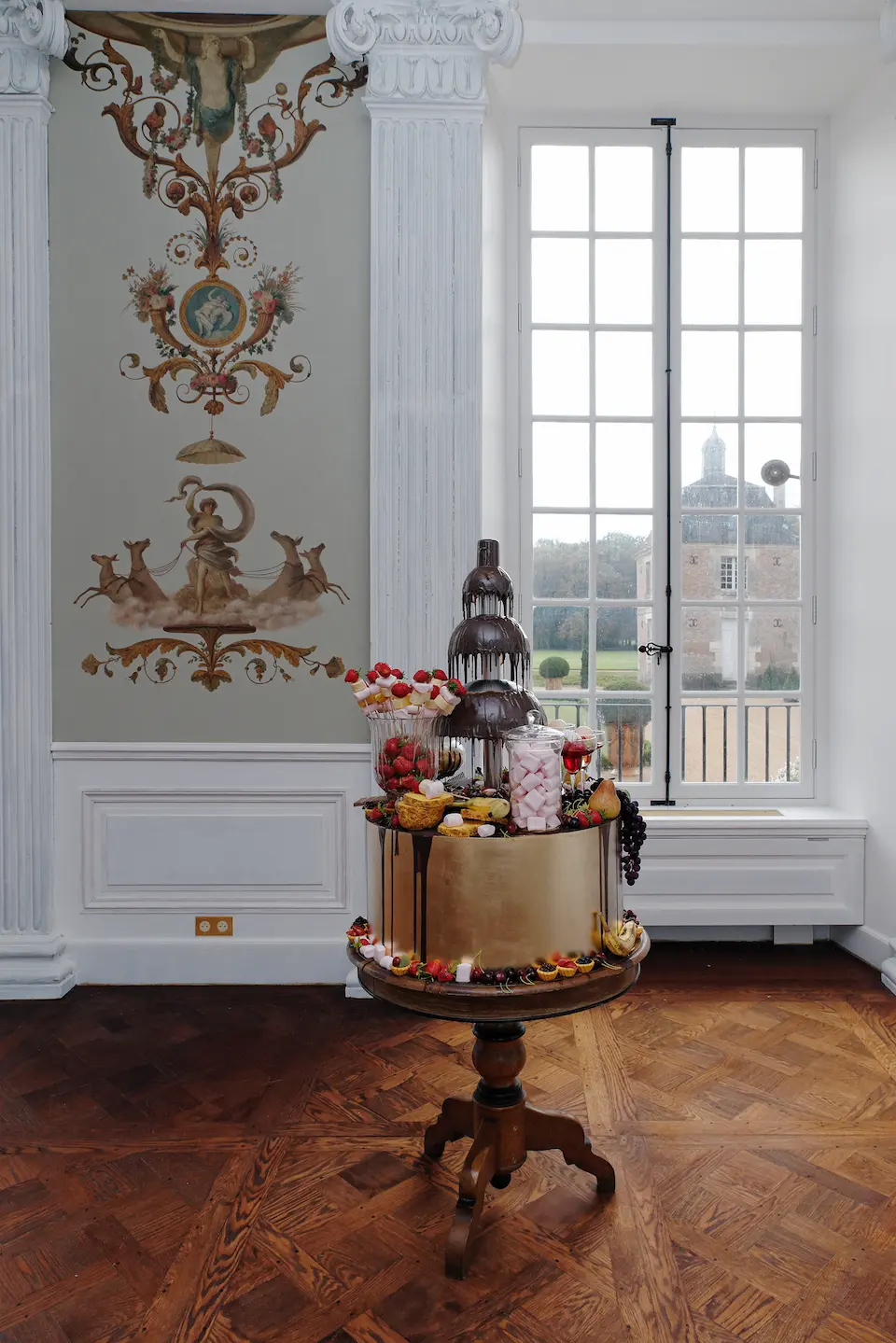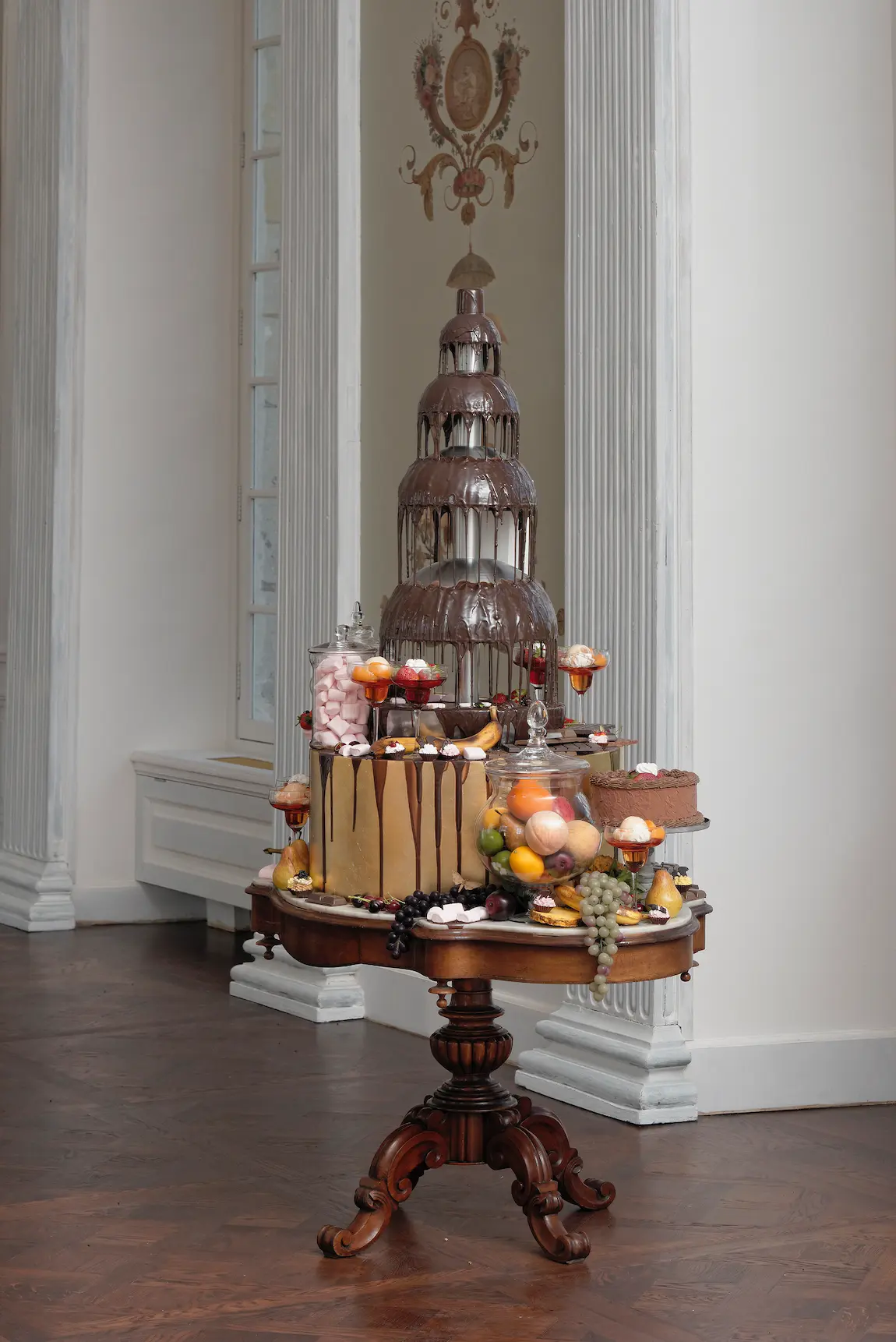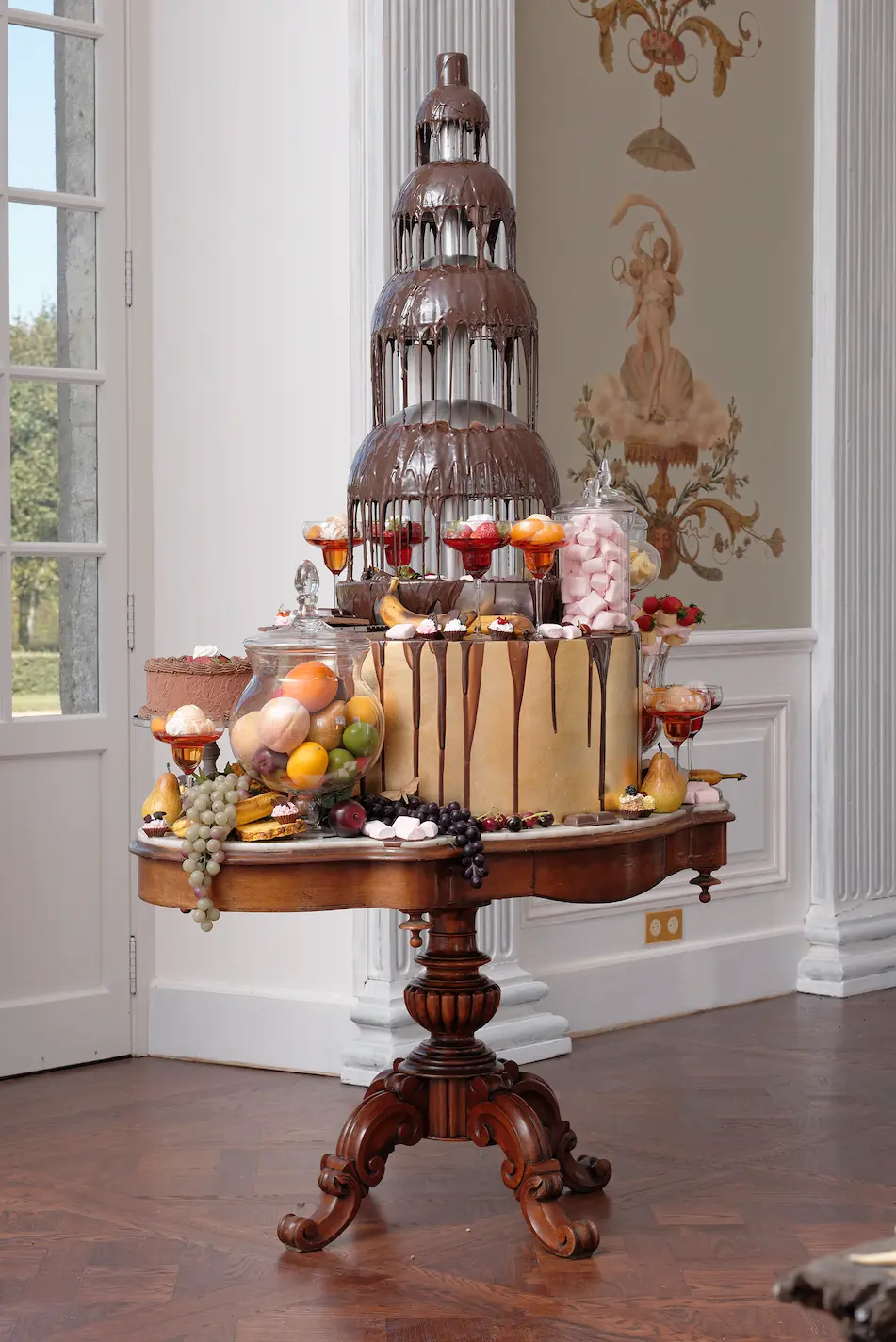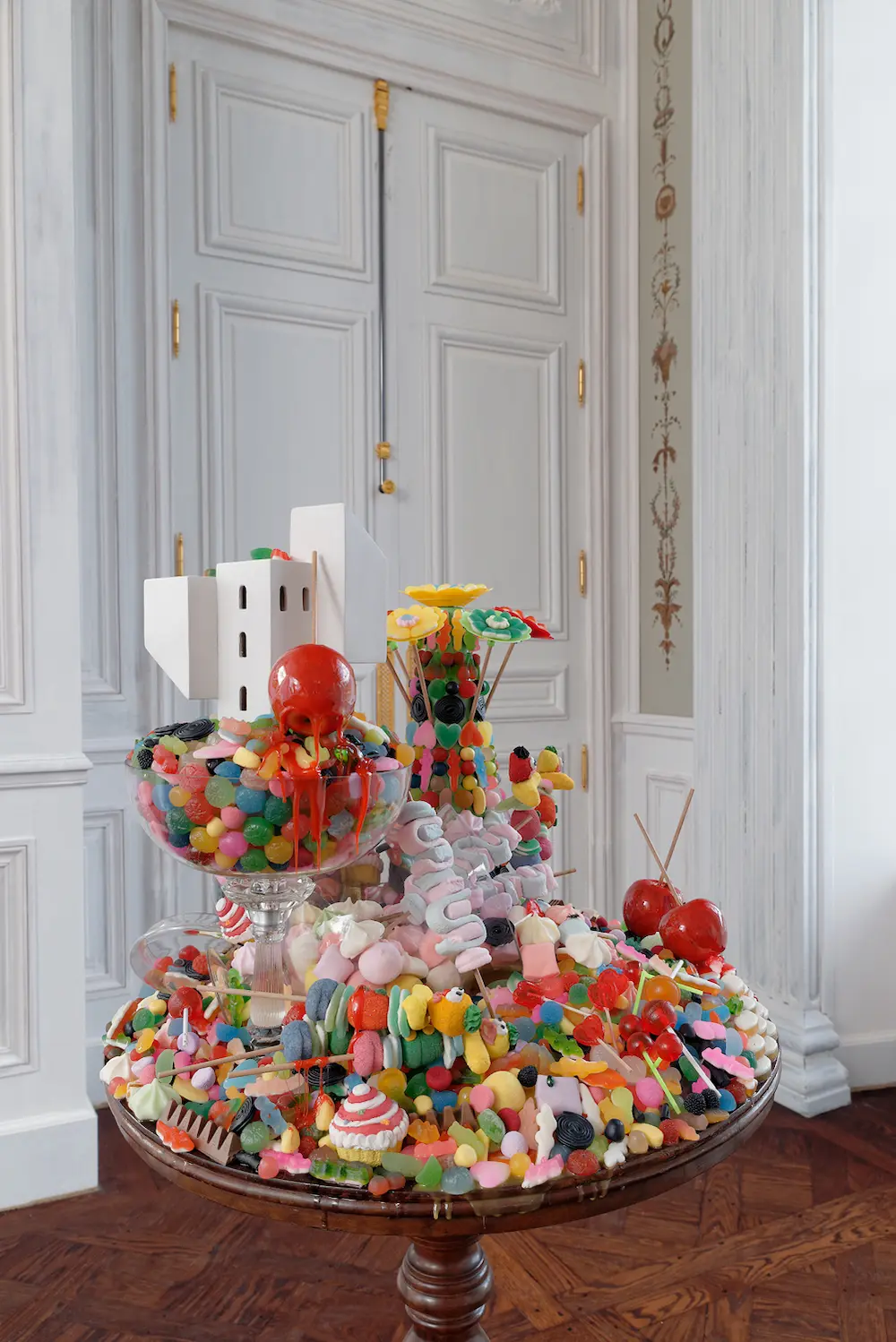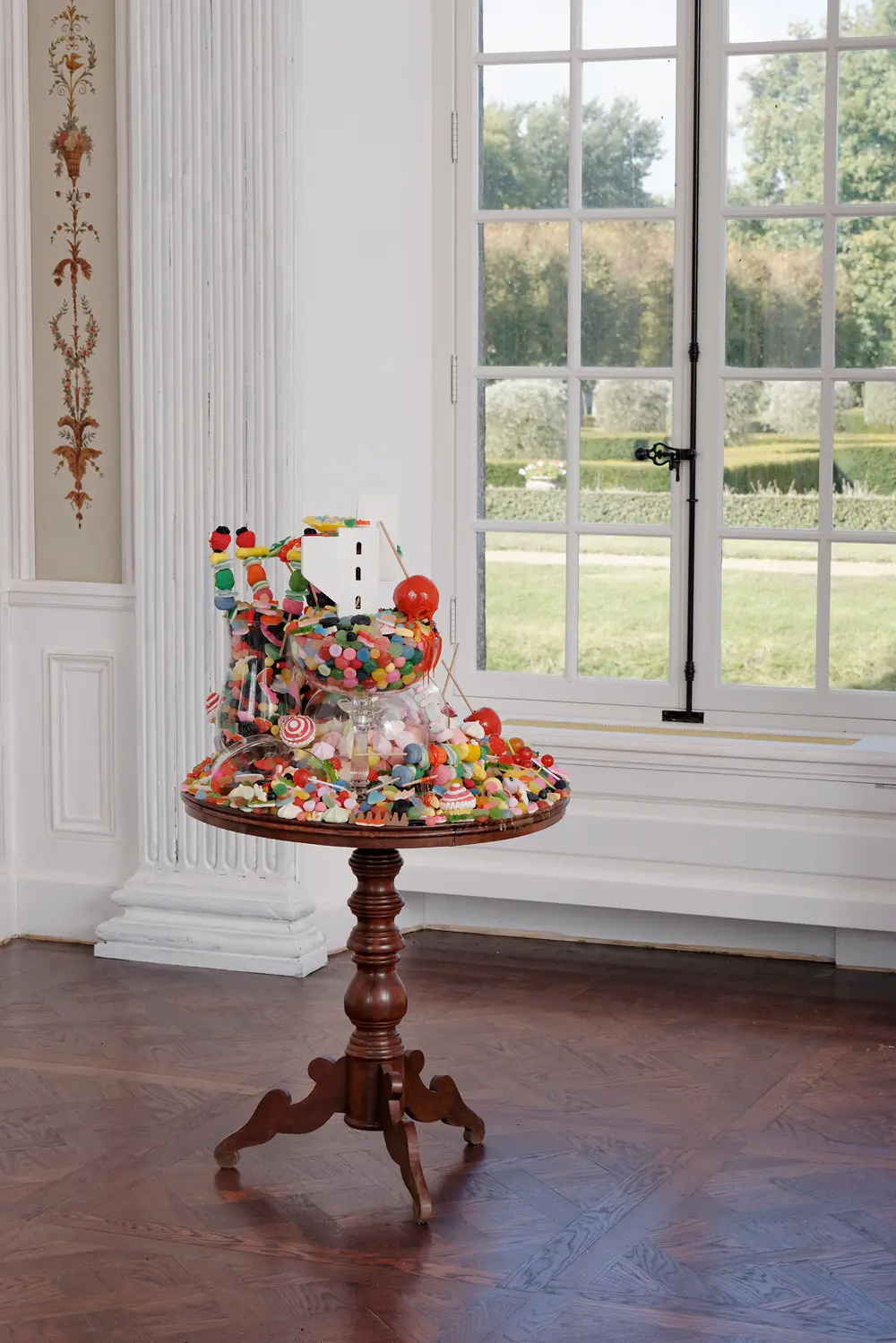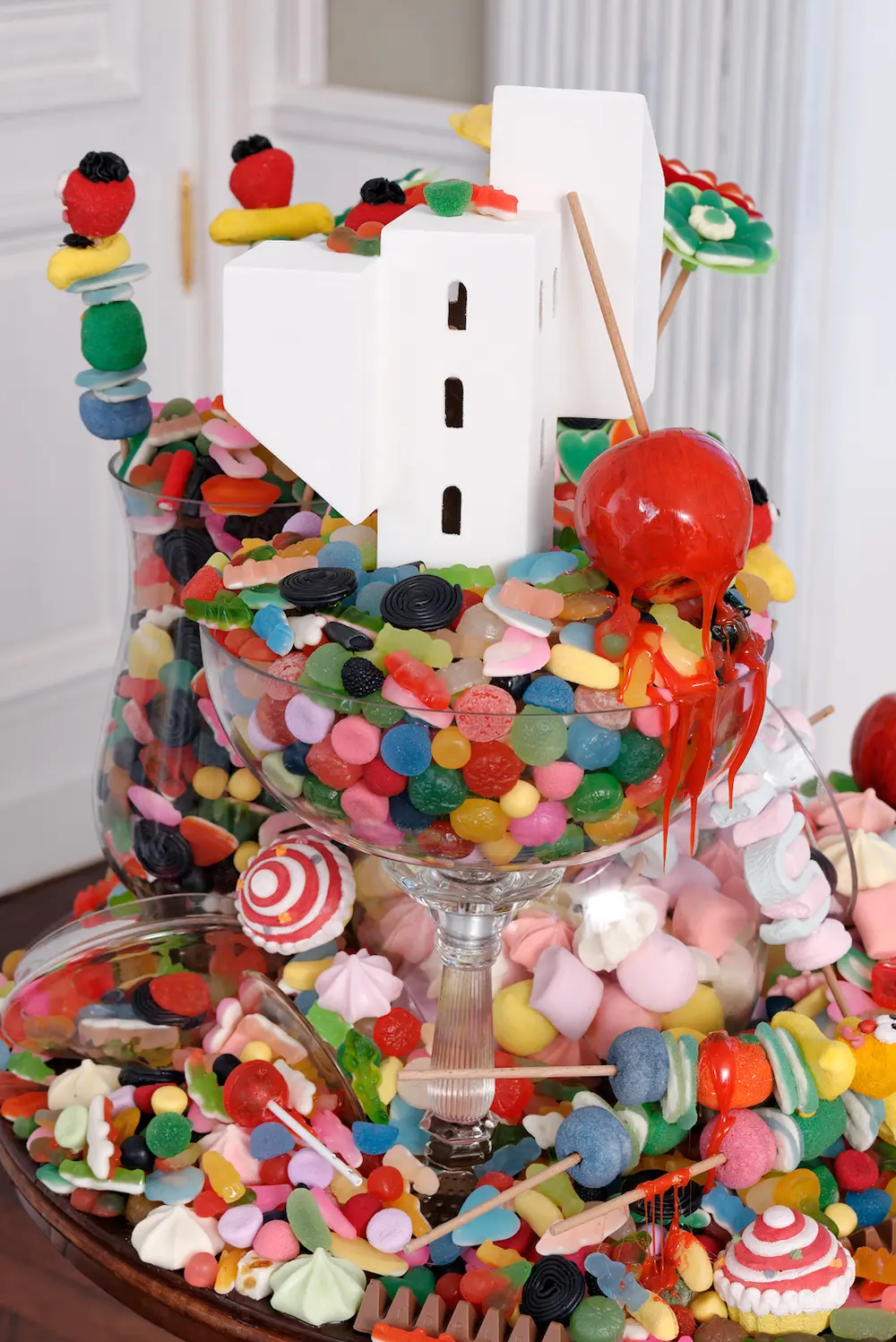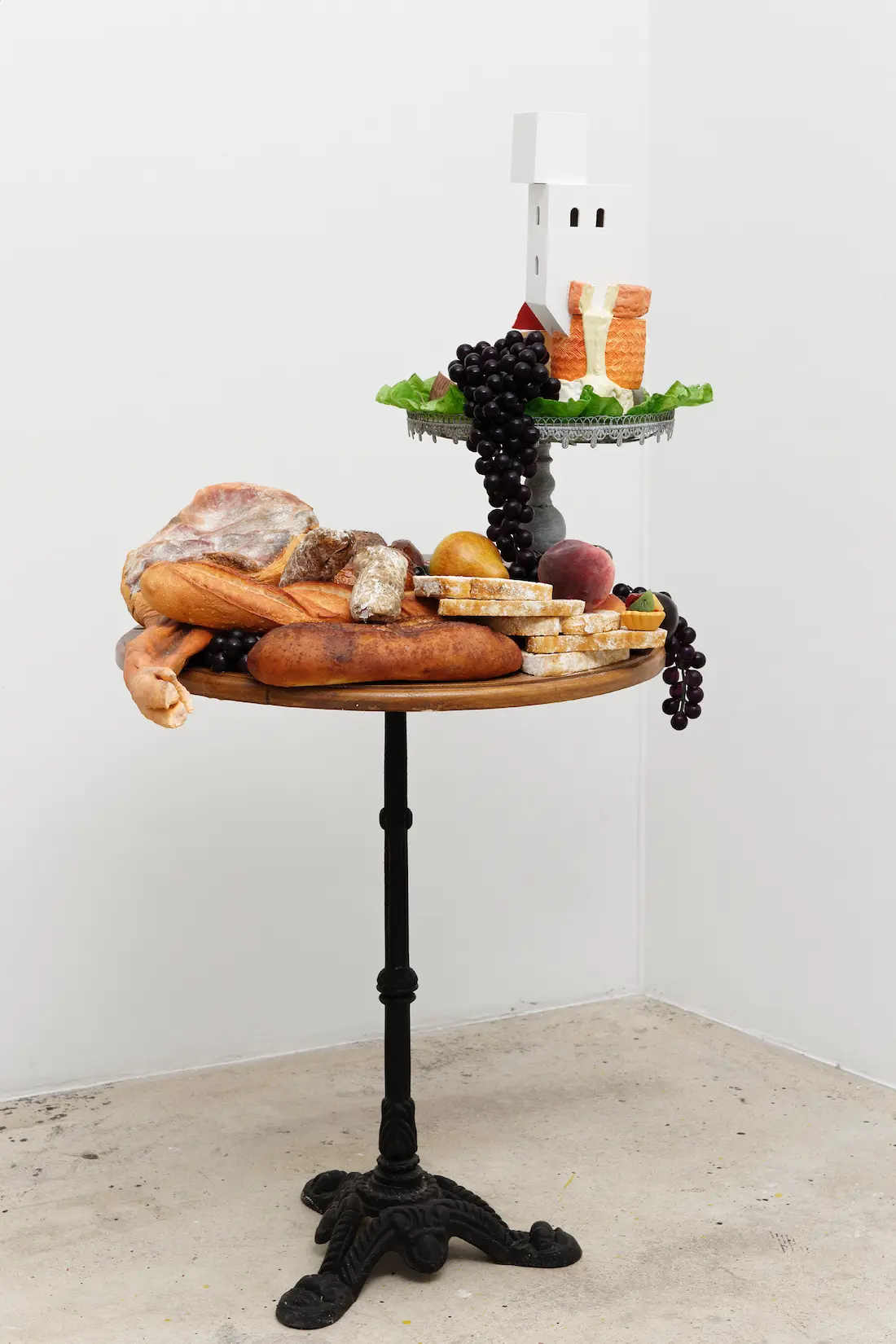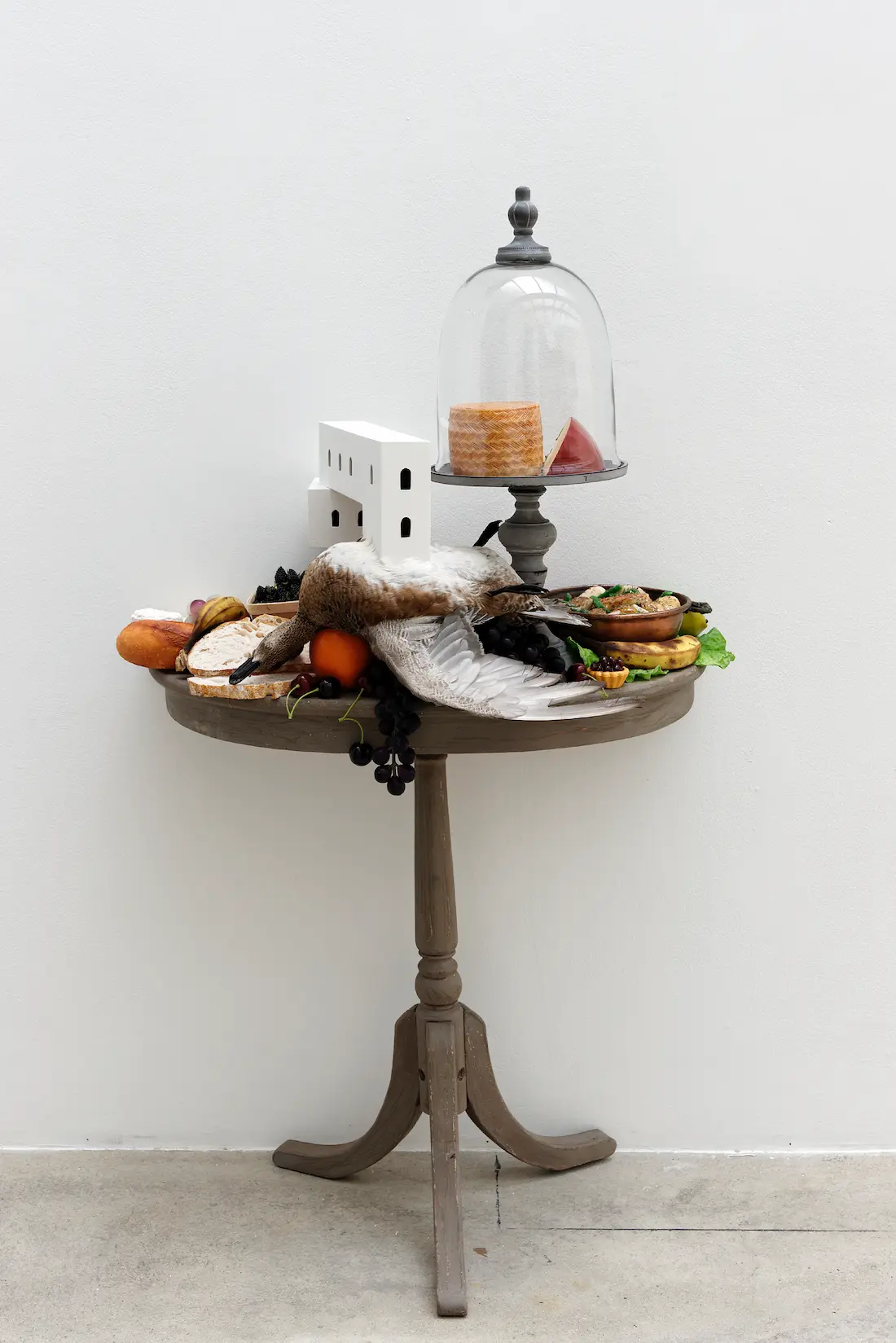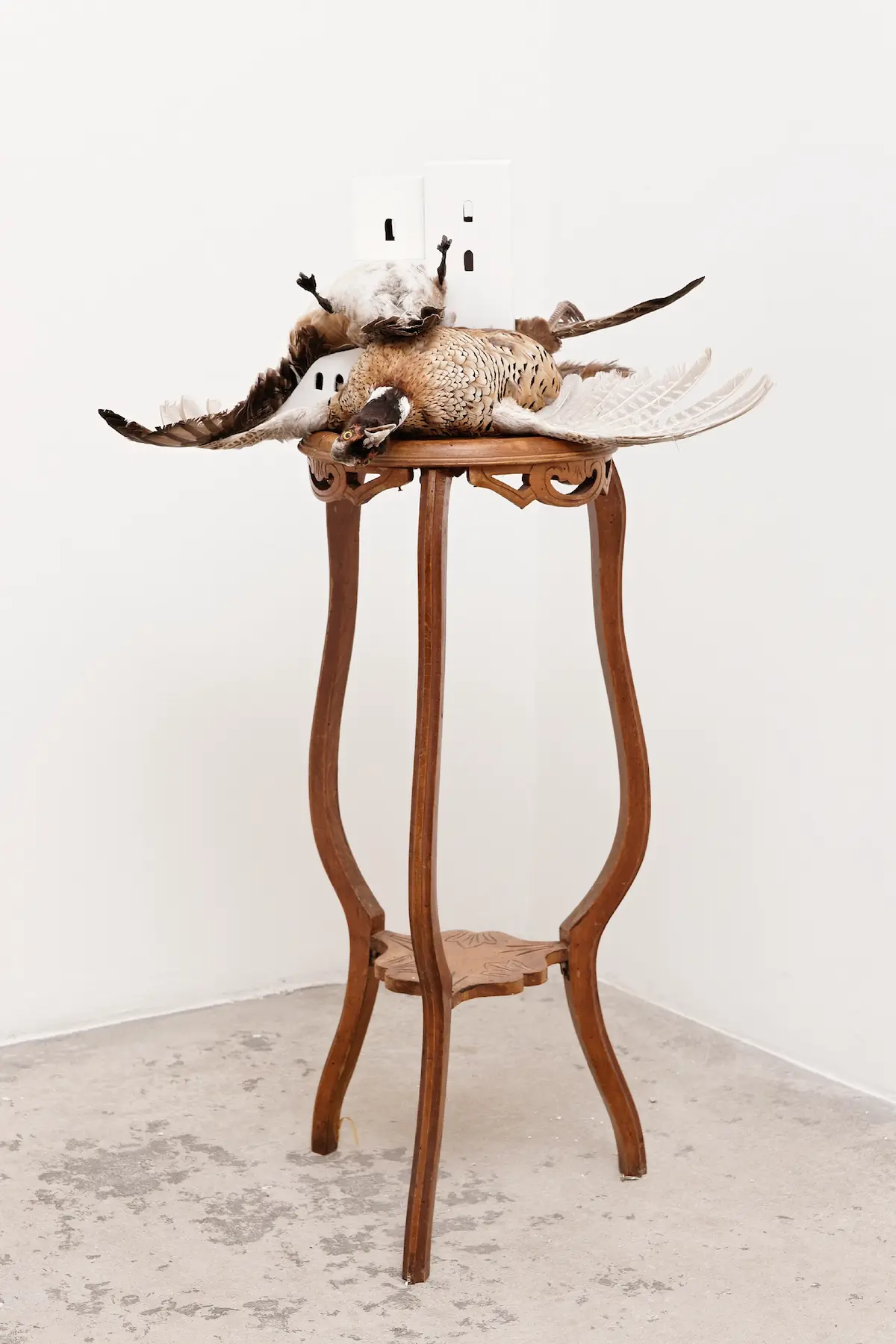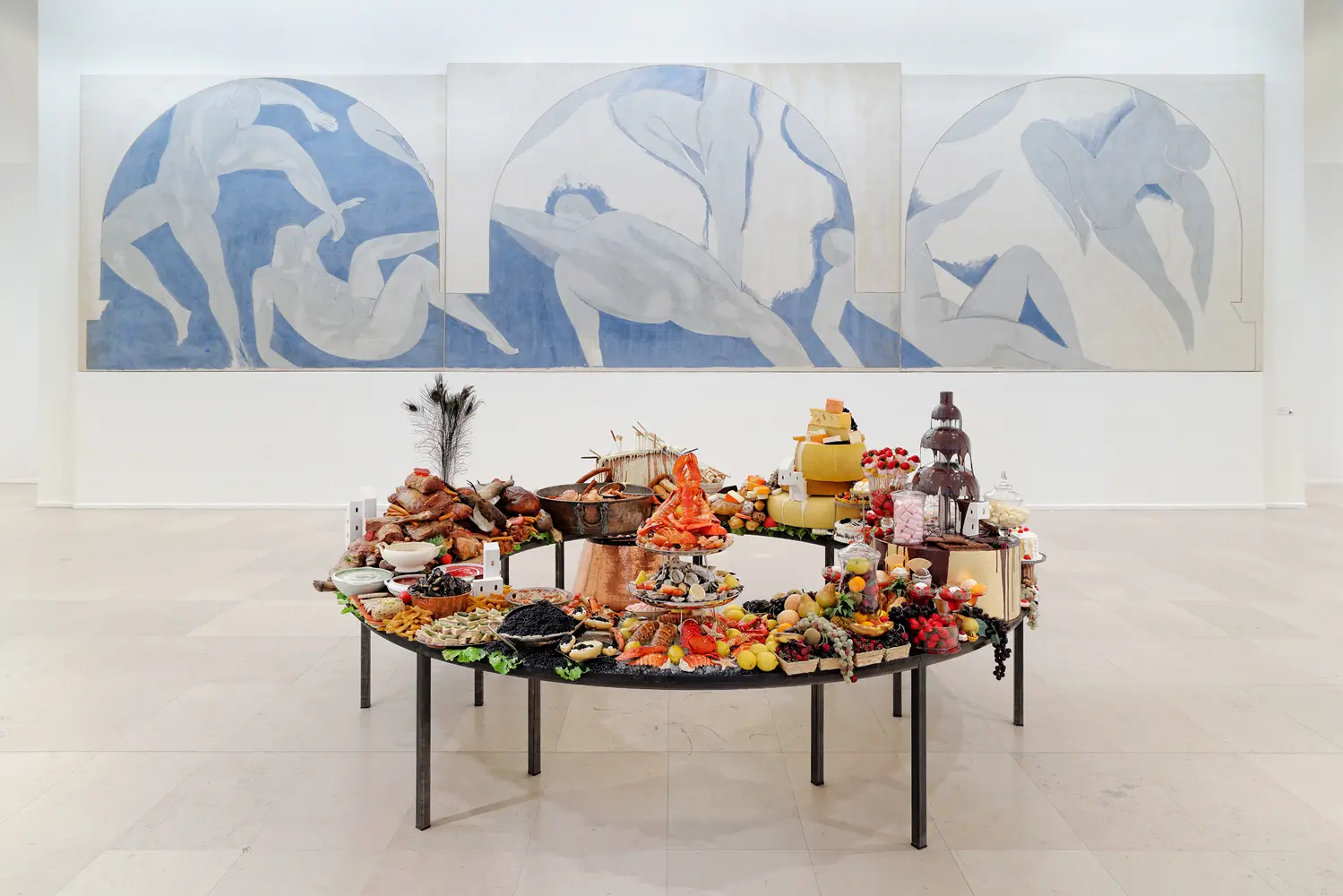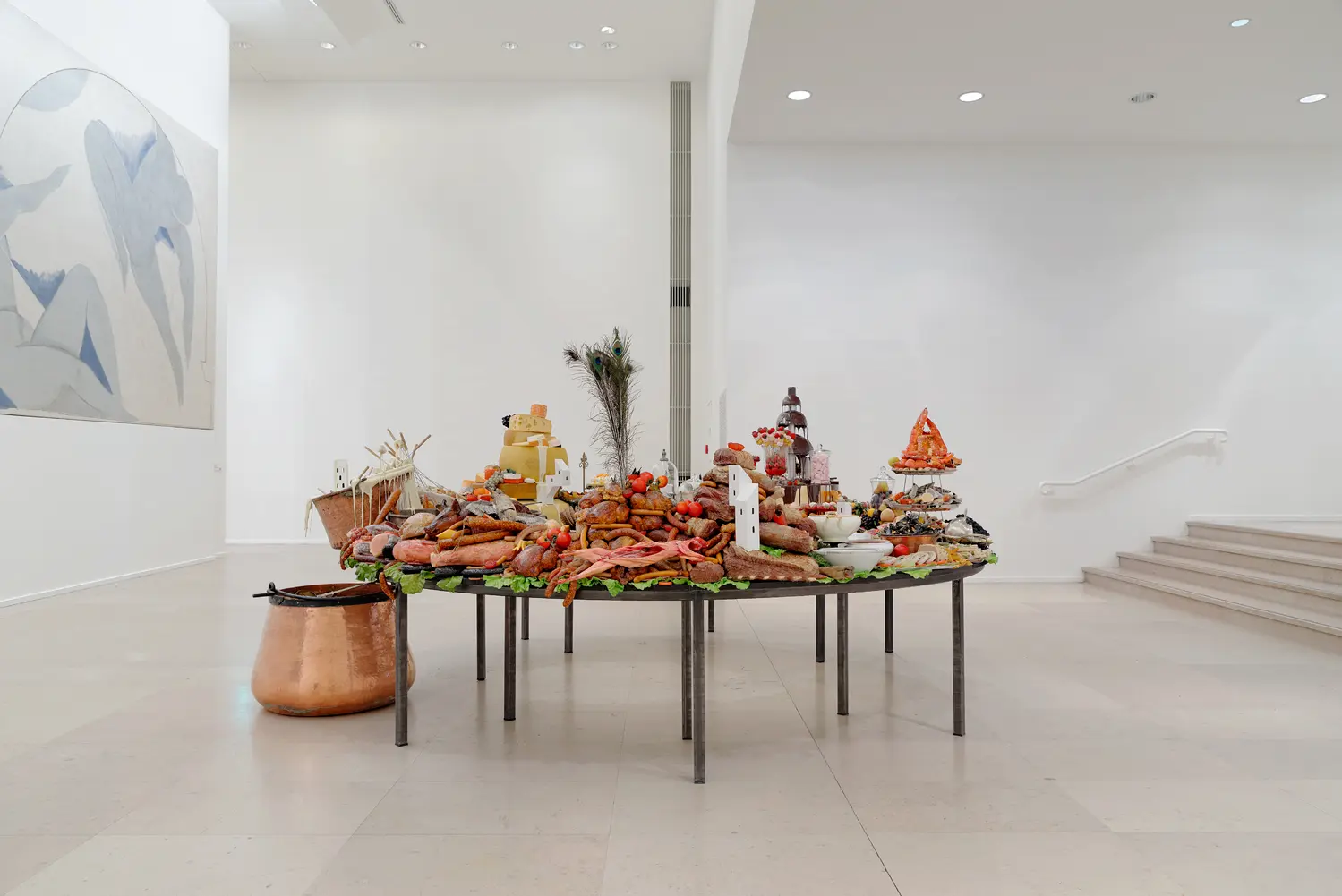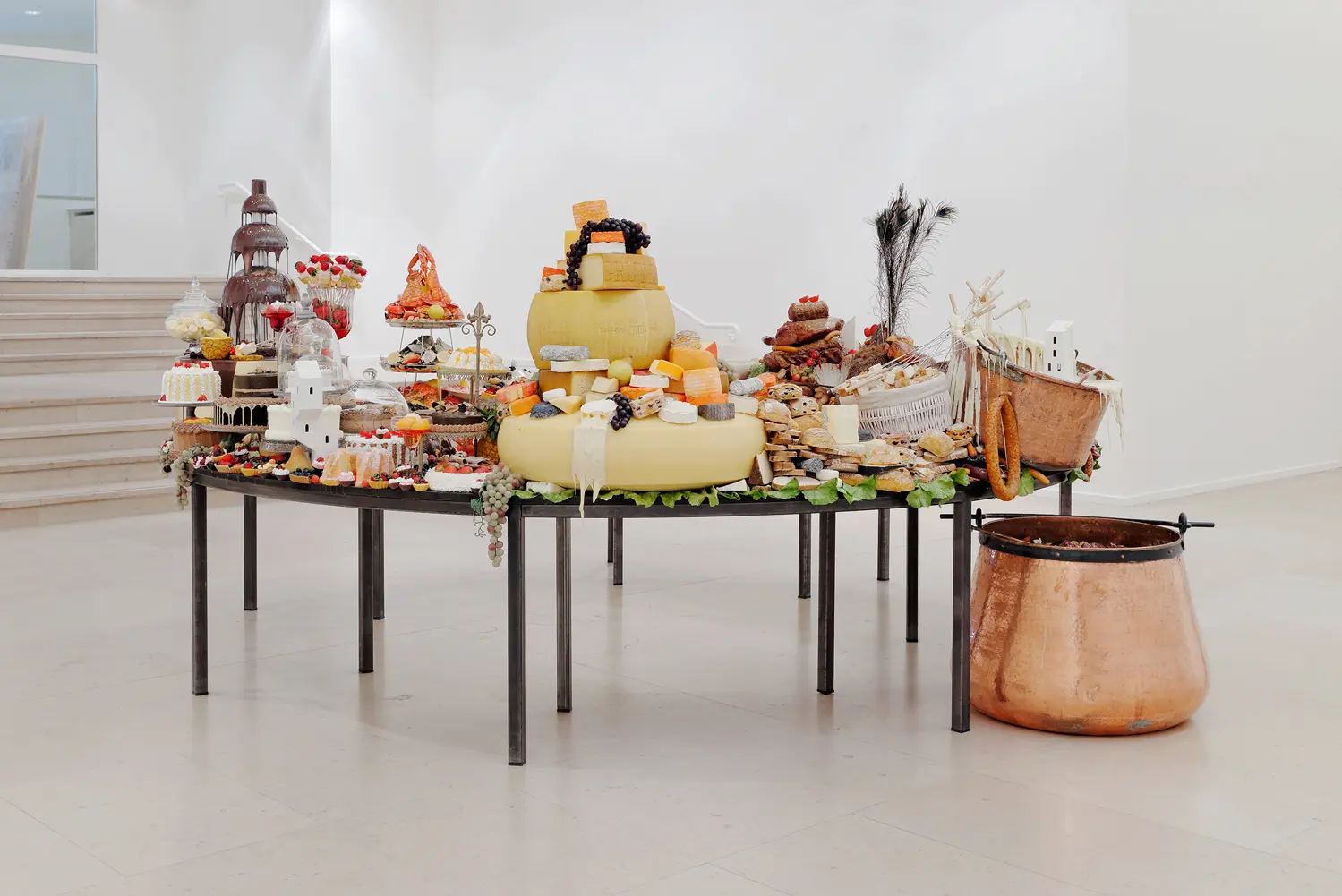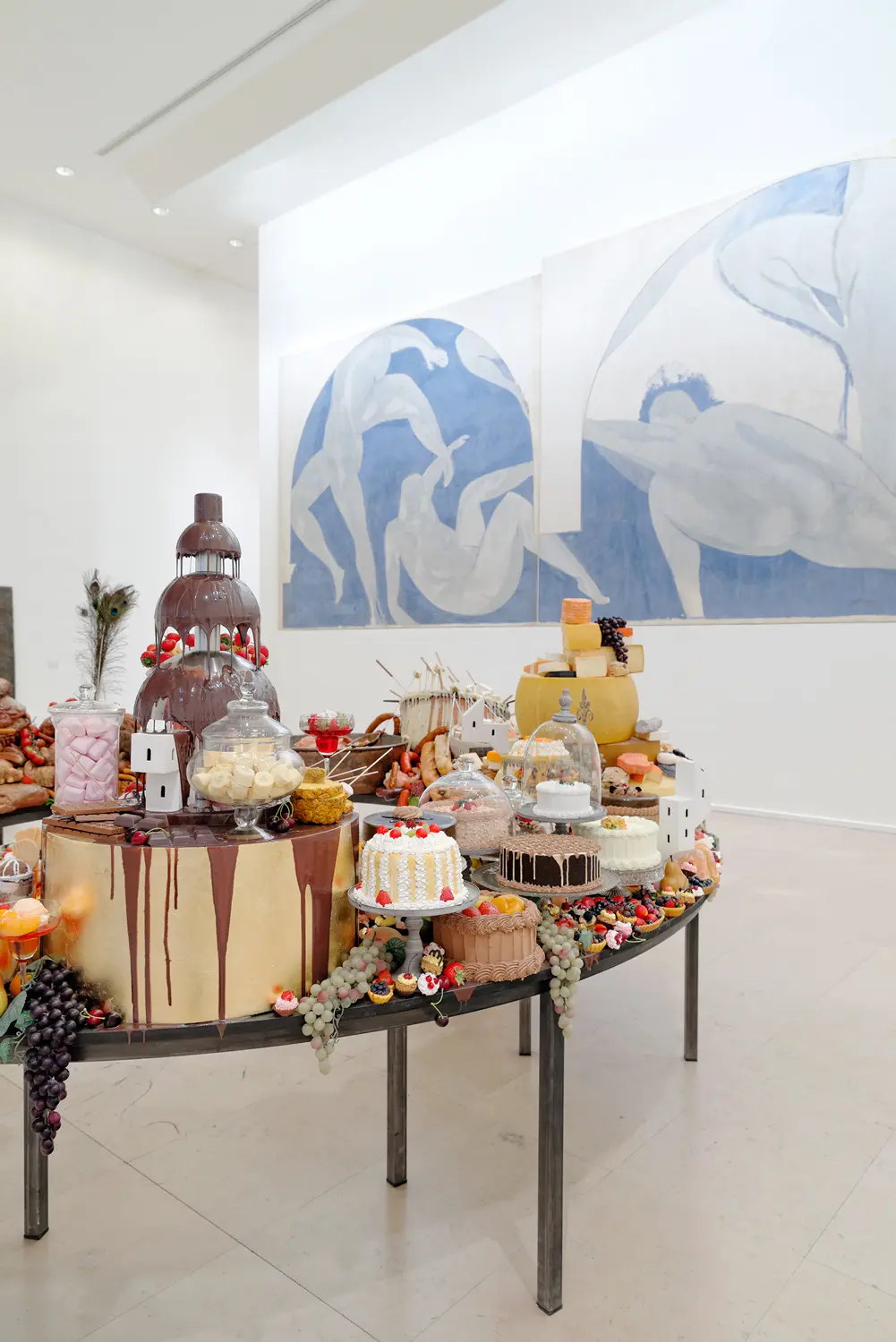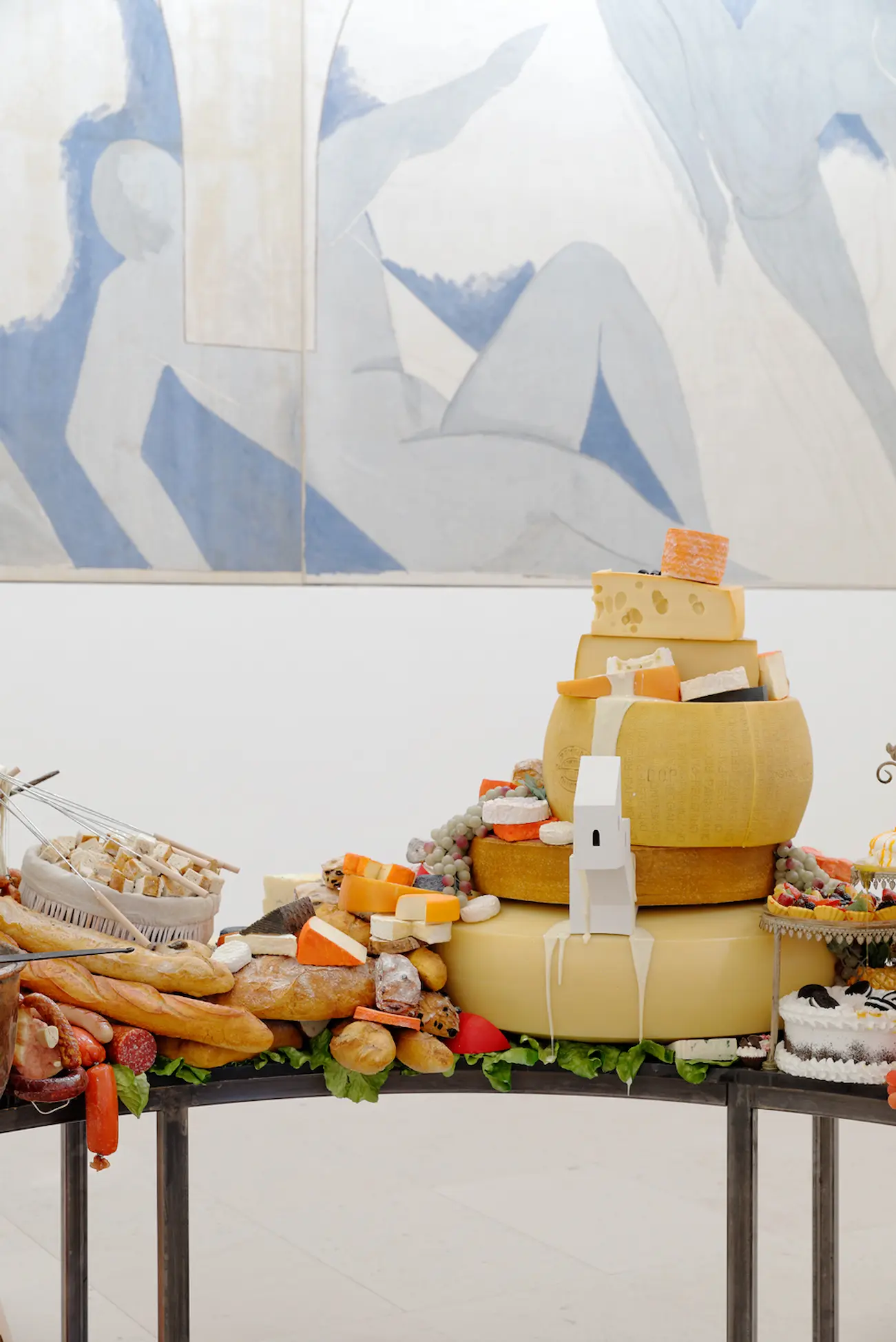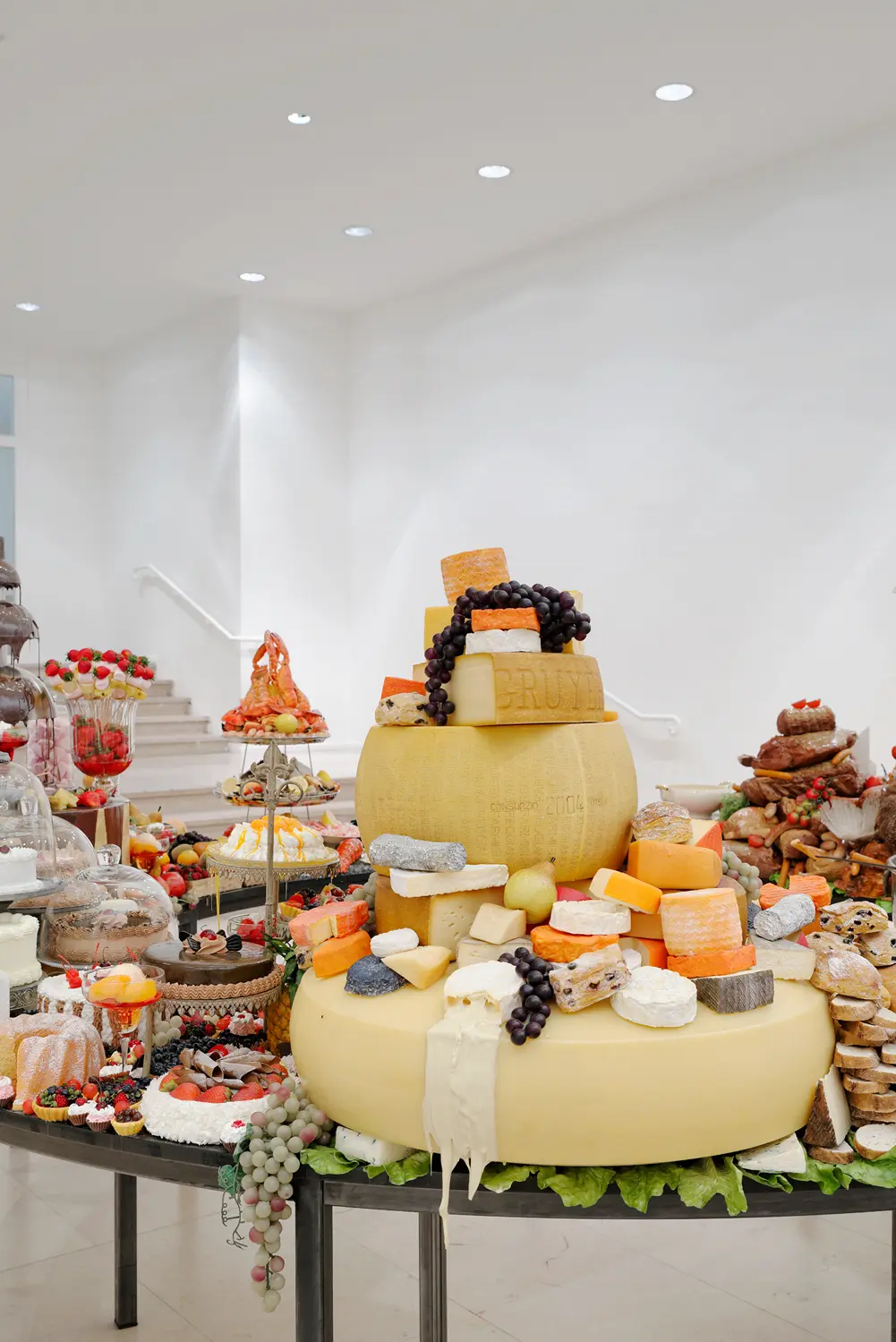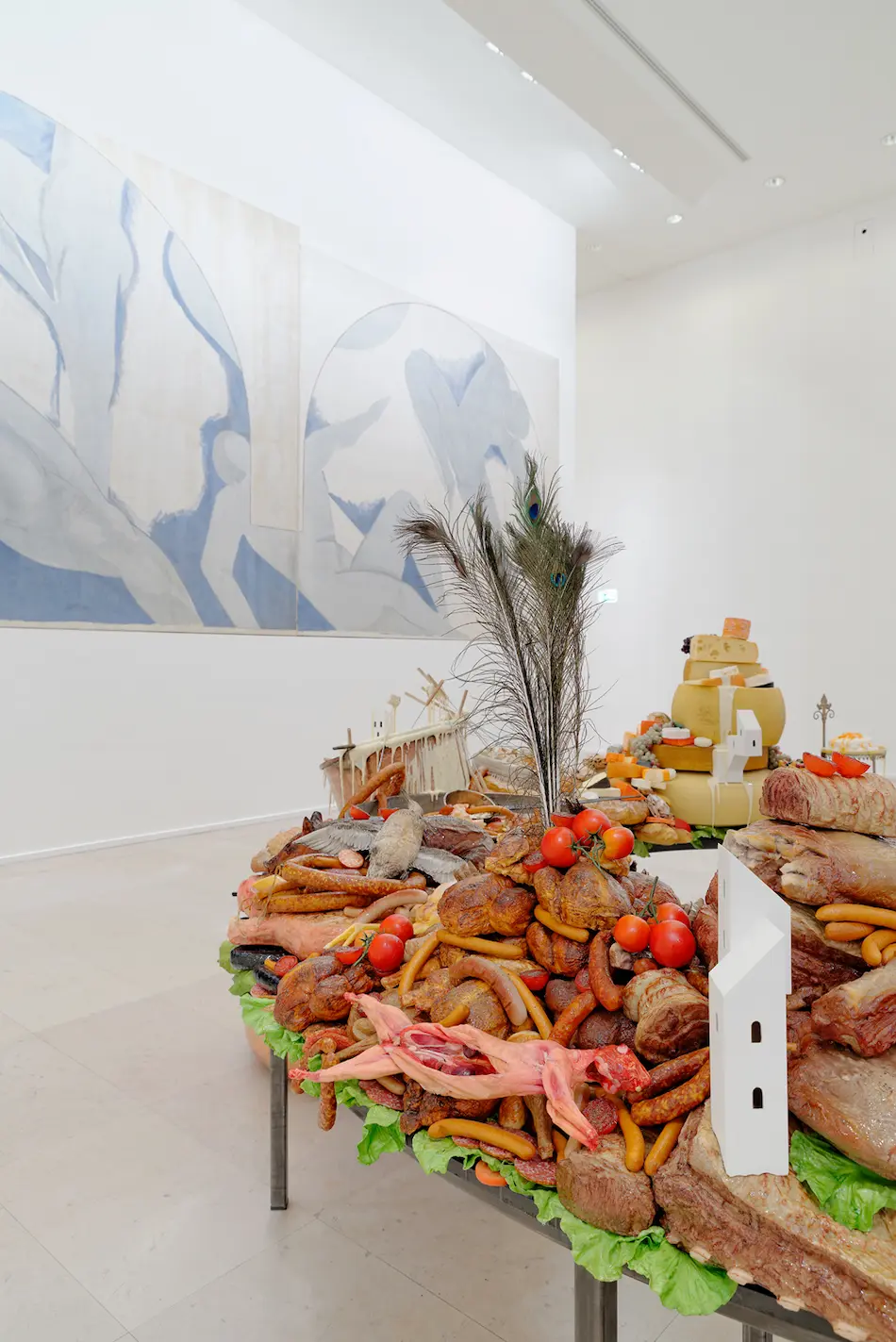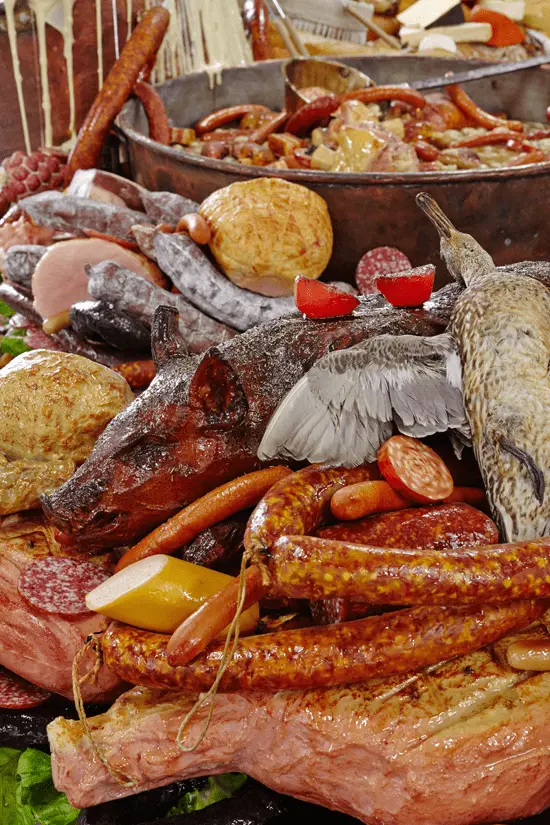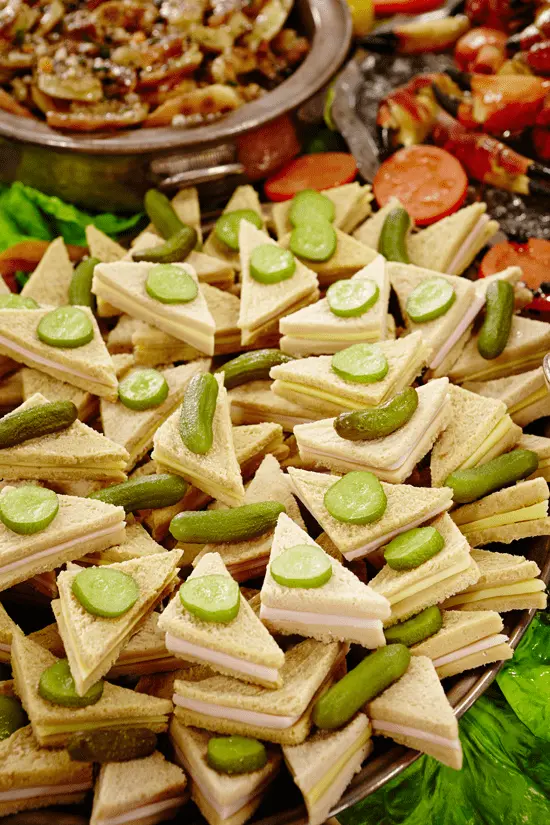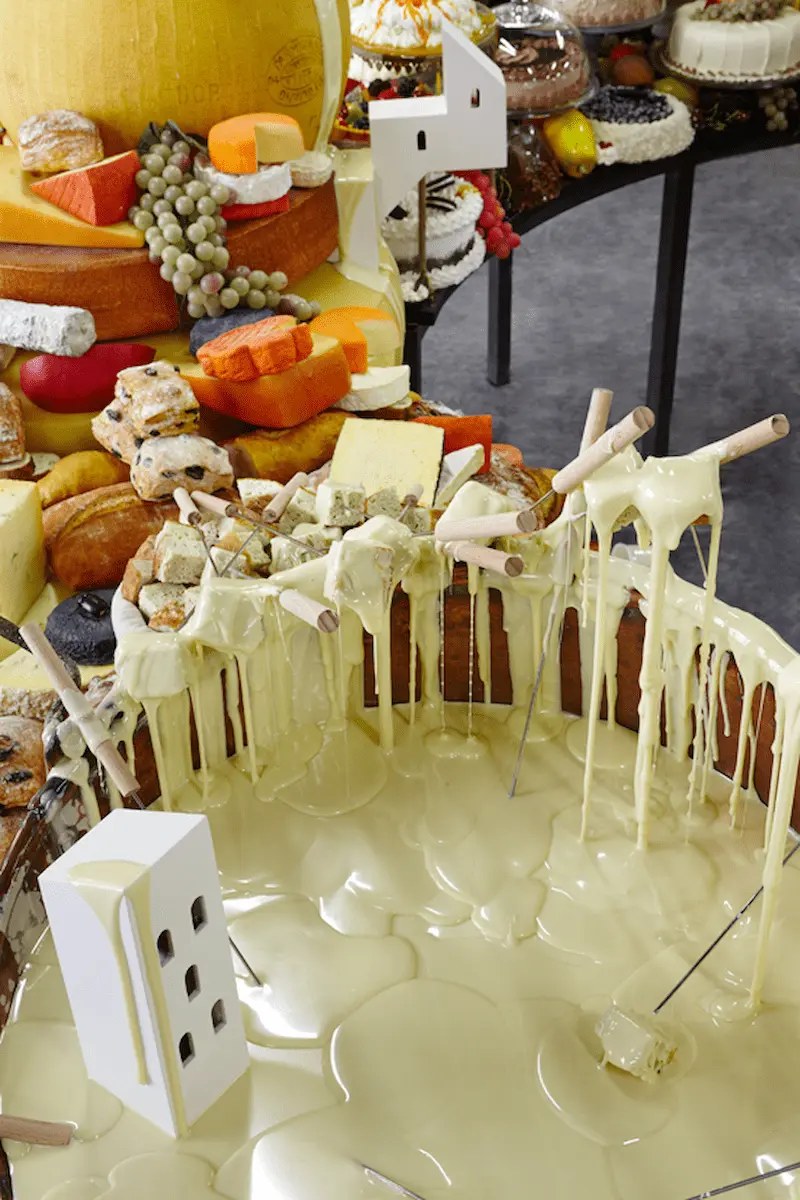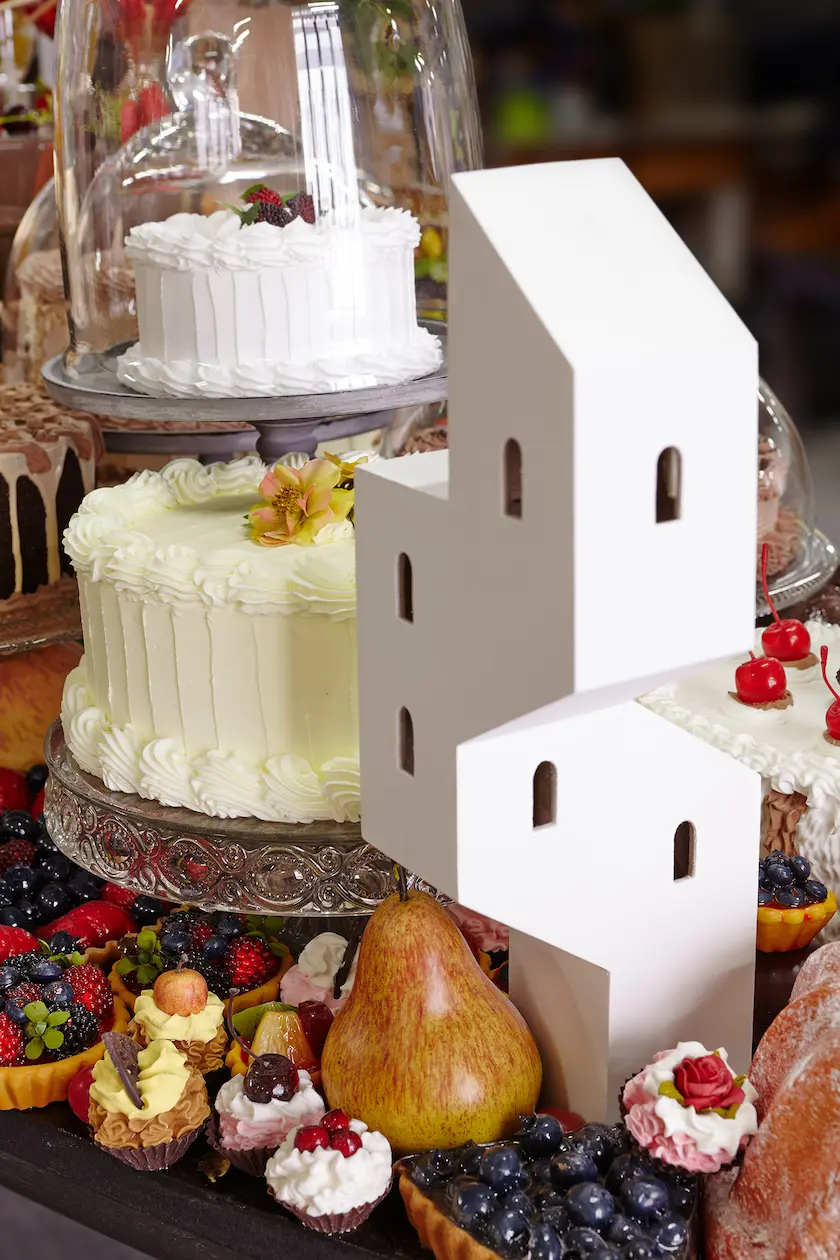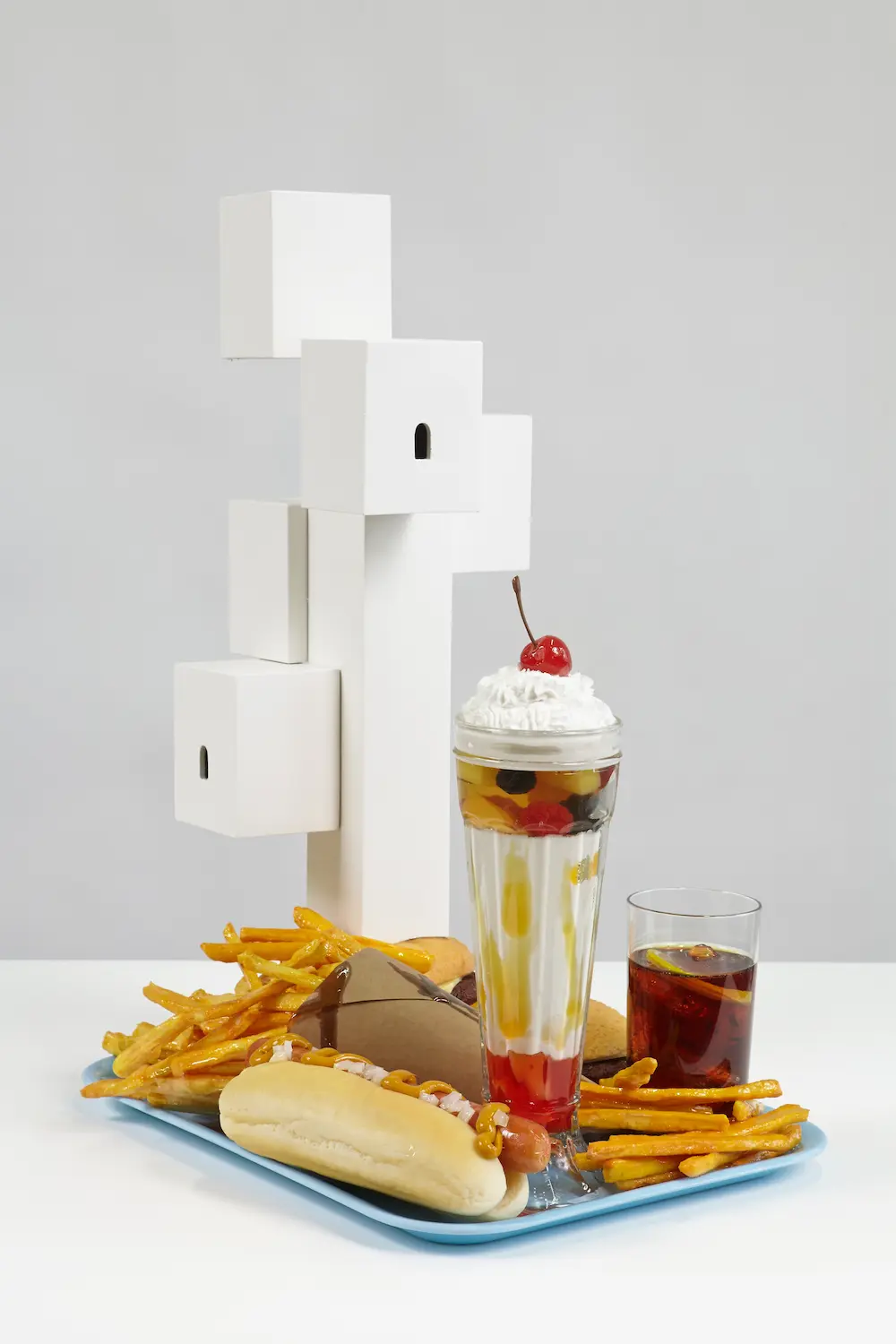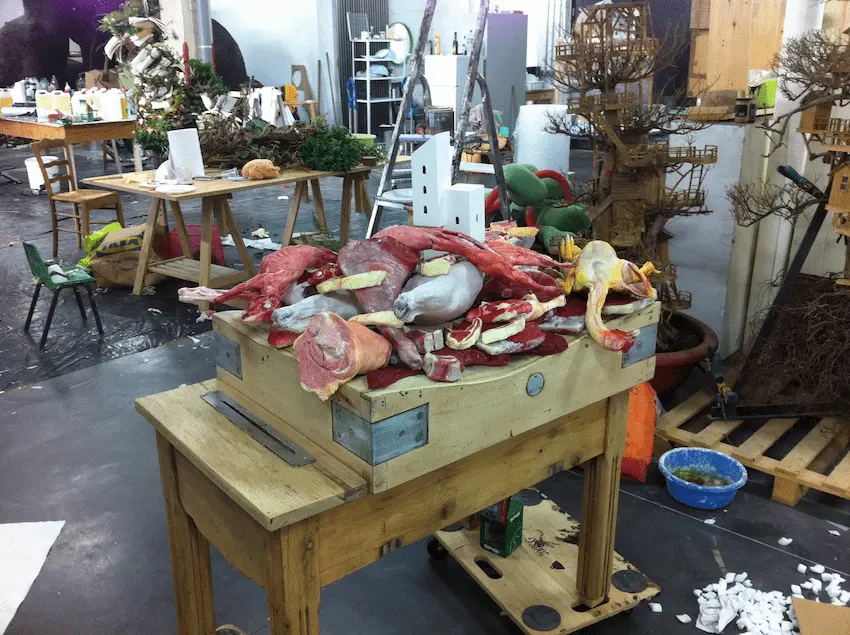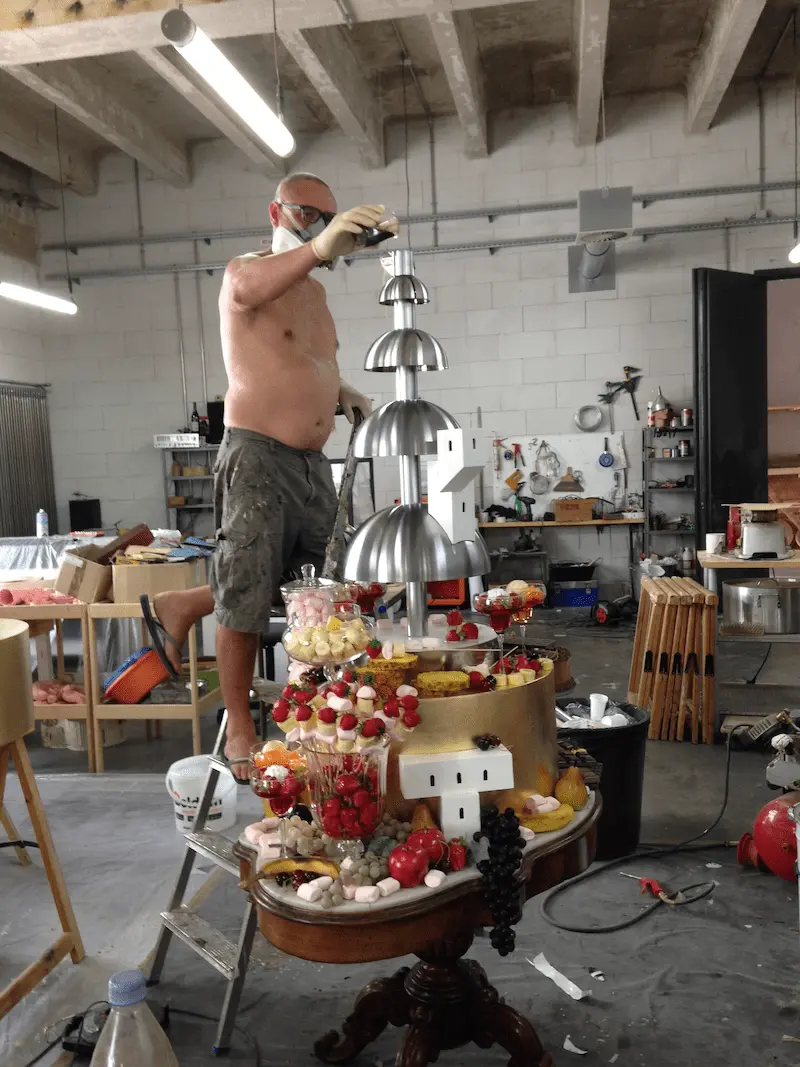References: Studies and recipes, Inhabiting painting, Locataire Mobilier, Cabins.
Inhabiting: Feasts, meats, pedestal tables, trays…
Since the Middle Ages, art has sought to free itself from craftsmanship, developing its spiritual and mental dimension. In the twentieth century, the separation is complete: artists manipulate objects made by others or, as producers, call on professionals for each technique. Barbier, on the other hand, embraces studio work, the pleasure of rendering the floured appearance of a baguette, the glaviness of an oyster. Obsessive, he controls every aspect of his work, constantly discovering new possibilities. Yet he doesn’t drown in a never-ending quest for formal perfection, as hyperrealistic artists often do. What interests him is carefully establishing production protocols that can be applied by others; hence these notebooks listing the colors, materials and proportions used. Each little cake, each chicken, is a technical world for which he gives us the recipe.
Read more
The hyperrealism that characterizes the banquet elements is molded in resin, composed of plastic, rubber and glass, and covered with glaze paint…. Their solidity seems to guarantee their permanence, frozen at the moment when the festivities are about to begin. The bewildering accumulation of food is offered and spread out on large sideboards, small pedestal tables or along a circular table without beginning or end, punctuated by the major stages of a meal: a seminal, perpetual, infinite, lethal feast.
However, its resemblance to perishable foodstuffs gives rise to the idea of decay and decomposition, like the harbinger of a disaster to come. This caloric atom bomb opens up a reflection on the culture of obesity and its corollaries, decay and collapse. One could say that these excessive feasts, these meats, are akin to the “potlatch”. This Amerindian rite boils down to making a gift so enormous that it can never be returned, thus placing the other party in a position of obligation and eternal submission. It’s a no-win situation, and you’ll leave with your eyes full but your hands empty.
In the depths of this food magma, small modernist architectures, balanced on what must disappear, refer to the instability, impermanence and fragility of all construction, whether real or mental. To the folly of believing that temples can be built on sand. Except here. Long time and short time intersect in unsettling pretense. Usually, you leave the table once the dishes have been gobbled up, cleaned up; these Feasts will continue to sparkle while you are nothing but dust.
From a text by Sébastien Gokalp for the “Festins” catalog, 2014.
“Inhabiting the Feast I”, 2013. Mixed media. 165 x 390 x 115 cm.
“Inhabiting the Feast I”, 2013. Mixed media. 165 x 390 x 115 cm.
“Inhabiting the Feast I”, 2013. Mixed media. 165 x 390 x 115 cm.
“Inhabiting the Feast I”, 2013. Mixed media. 165 x 390 x 115 cm.
“Inhabiting the Feast I”, 2013. Mixed media. 165 x 390 x 115 cm.
“Inhabiting the Feast I”, 2013. Mixed media. 165 x 390 x 115 cm.
” The Feast Table “, 2013, mixed technique,165 x 390 x 115 cm
” The Feast Table “, 2013, mixed technique,165 x 390 x 115 cm
” The Feast Table “, 2013, mixed technique,165 x 390 x 115 cm
” The Feast Table “, 2013, mixed technique,165 x 390 x 115 cm
” The Feast Table “, 2013, mixed technique,165 x 390 x 115 cm
” The Feast Table “, 2013, mixed technique,165 x 390 x 115 cm
” Pedestal table with piglet “, 2014, mixed technique, 115 x 80 x 62 cm
” Pedestal table with piglet “, 2014, mixed technique, 115 x 80 x 62 cm
” Pedestal table with piglet “, 2014, mixed technique, 115 x 80 x 62 cm
” Pedestal table with piglet “, 2014, mixed technique, 115 x 80 x 62 cm
“ Inhabiting Raw Meat (Lamb) ”, 2013. Mixed media. 117 x 50 x 73 cm.
“ Inhabiting Raw Meat (Lamb) ”, 2013. Mixed media. 117 x 50 x 73 cm.
“ Inhabiting Raw Meat (Lamb) ”, 2013. Mixed media. 117 x 50 x 73 cm.
“ Inhabiting Raw Meat (Lamb) ”, 2013. Mixed media. 117 x 50 x 73 cm.
” The village “, 2015, mixed media, variable dimensions
” The village “, 2015, mixed media, variable dimensions
“ Inhabiting Raw Meat (The Village) ”, 2014. Mixed media. Variable dimensions.
“ Inhabiting Raw Meat (The Village) ”, 2014. Mixed media. Variable dimensions.
“Inhabiting the Meat (The Billot)”, 2013. Mixed media. 120 x 102 x 62 cm.
“Inhabiting the Meat (The Billot)”, 2013. Mixed media. 120 x 102 x 62 cm.
” The Billot “, 2013, mixed technique, 120 x 102 x 62 cm
” The Billot “, 2013, mixed technique, 120 x 102 x 62 cm
” Pedestal table with Caviar ” #2, 2022, mixed technique, 94 x 56 x 56 cm
” Pedestal table with Caviar ” #2, 2022, mixed technique, 94 x 56 x 56 cm
” Pedestal table with Caviar “, 2014, mixed media.
” Pedestal table with Caviar “, 2014, mixed media.
“Pedestal table with soups”, 2014, mixed media, 126 x 117 x 87 cm.
“Pedestal table with soups”, 2014, mixed media, 126 x 117 x 87 cm.
“Pedestal table with soups”, 2014, mixed media, 126 x 117 x 87 cm.
“Pedestal table with soups”, 2014, mixed media, 126 x 117 x 87 cm.
” The Little Chocolate Fountain “, 2014, mixed media, 168 x 77 x x 77 cm
” The Little Chocolate Fountain “, 2014, mixed media, 168 x 77 x x 77 cm
” Big Chocolate Fountain “, 2014, mixed technique, 210 x 130 x 82 cm
” Big Chocolate Fountain “, 2014, mixed technique, 210 x 130 x 82 cm
” Big Chocolate Fountain “, 2014, mixed technique, 210 x 130 x 82 cm
” Big Chocolate Fountain “, 2014, mixed technique, 210 x 130 x 82 cm
“Pedestal Table with Sweets”, 2014, mixed media, 134 x 73 x 73 cm
“Pedestal Table with Sweets”, 2014, mixed media, 134 x 73 x 73 cm
” Pedestal table with pig’s feet “, 2013, mixed technique, 131 x 80 x 64 cm
” Pedestal table with pig’s feet “, 2013, mixed technique, 131 x 80 x 64 cm
“Pedestal Table’ with Duck”, 2013, mixed media, 130 x 75 x 47 cm
“Pedestal Table’ with Duck”, 2013, mixed media, 130 x 75 x 47 cm
” Pedestal table with poultry “, 2013, mixed technique, 103 x 78 x 63 cm
” Pedestal table with poultry “, 2013, mixed technique, 103 x 78 x 63 cm
“Inhabiting (The Feast Table II)”, 2014. Mixed media. 195 x 355 x 355 cm. Collection : Museum of Modern Art, Paris. Musée d’art Moderne de la Ville de Paris collection.
“Inhabiting (The Feast Table II)”, 2014. Mixed media. 195 x 355 x 355 cm. Collection : Museum of Modern Art, Paris.
” The Feast ” #2, 2014. mixed media. 195 x 355 x 355 cm.
” The Feast ” #2, 2014. mixed media. 195 x 355 x 355 cm.
” The Feast ” #2, 2014. mixed media. 195 x 355 x 355 cm.
” The Feast ” #2, 2014. mixed media. 195 x 355 x 355 cm (Musée d’Art Moderne de la Ville de Paris).
“Hamburger Platter”, 2013, mixed media, 46 x 36 x 26 cm
“Hamburger Platter”, 2013, mixed media, 46 x 36 x 26 cm
“Hamburger Platter”, 2013, mixed media, 46 x 36 x 26 cm
“Hamburger Platter”, 2013, mixed media, 46 x 36 x 26 cm
